On Wednesday, March 14, work started on the relay of 67m of track in mass concrete starting from ‘Depot Junction’ and running up the grade to pole 28. It is expected that this work will take 12 weeks to complete, but this is dependent on both weather and funds to purchase concrete.
The rail to be used for this work was recovered from Anzac Parade, Kensington and was donated by the contractor working on that section of the new CESLR works.
P1497 ran the final trip to the National Park for the time being on the afternoon of the 14th of March.
Scope of Works
- New track drain to be installed 10 metres South of the boundary gate to help capture and remove any excess water overflowing from Sydney Trains railway easement.
- Concrete encase the track and track drains South from the existing concreted Depot points through to pole 28
- Build a sandstone retaining wall from the South boundary gate to Pole 28 along the western boundary
- Certify track for operational use.
- Reinstate grass and tidy up the area.
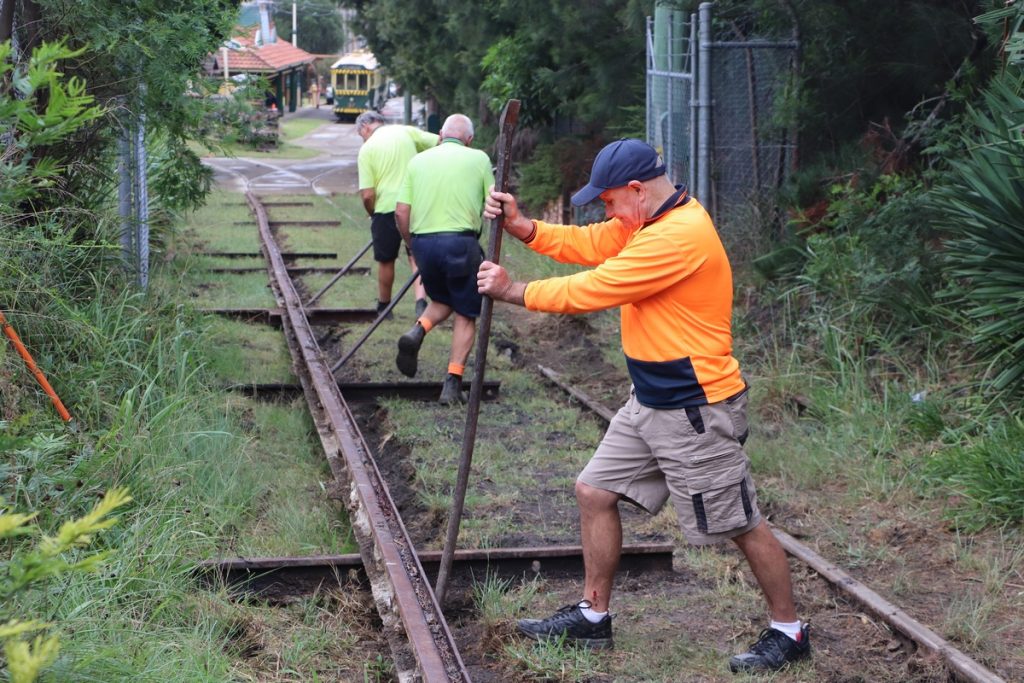
Moving the ‘new’ western rail over 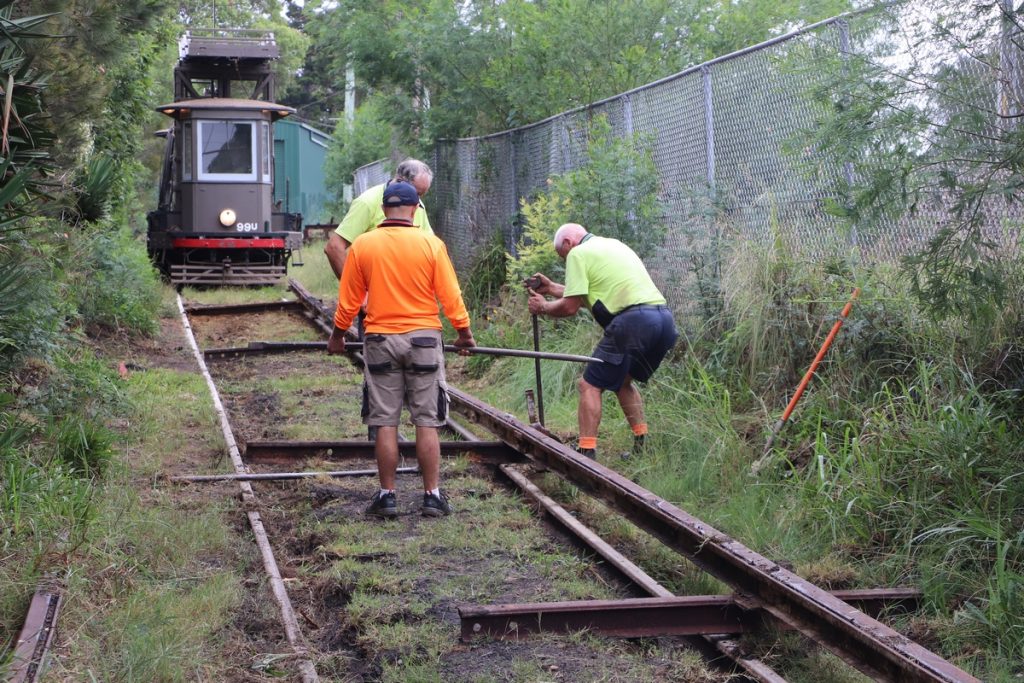
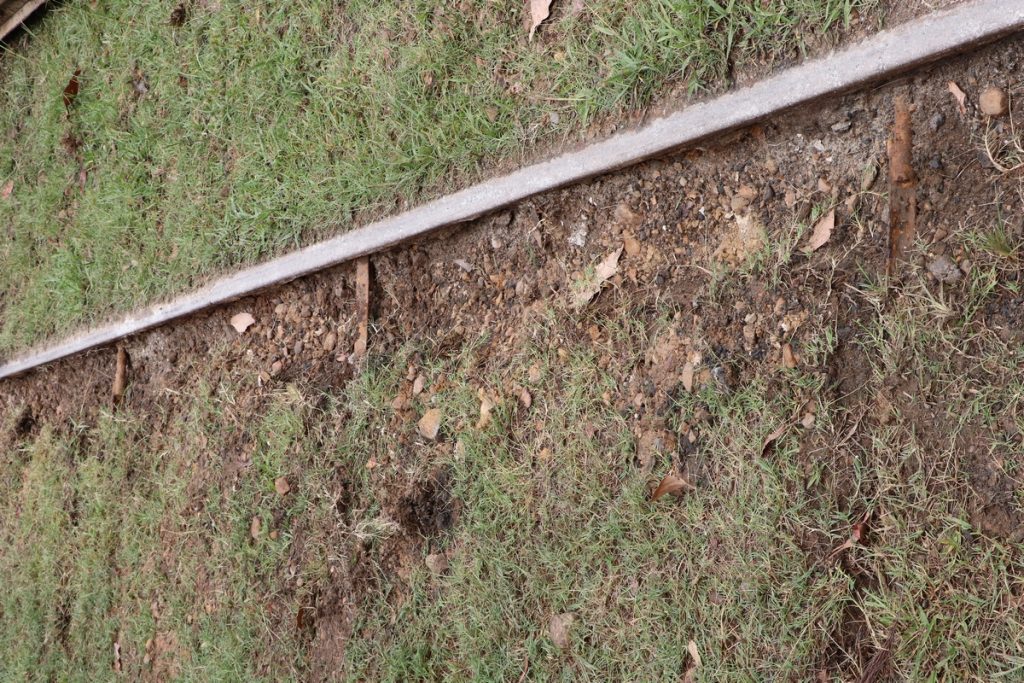
Tie bars being exposed 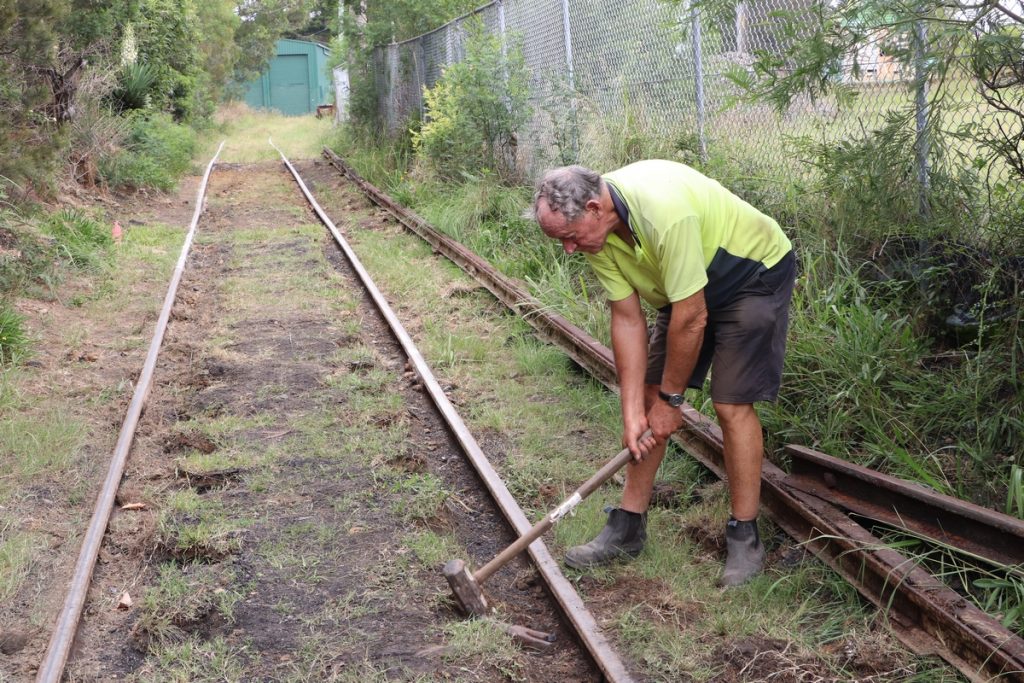
Spikes being removed 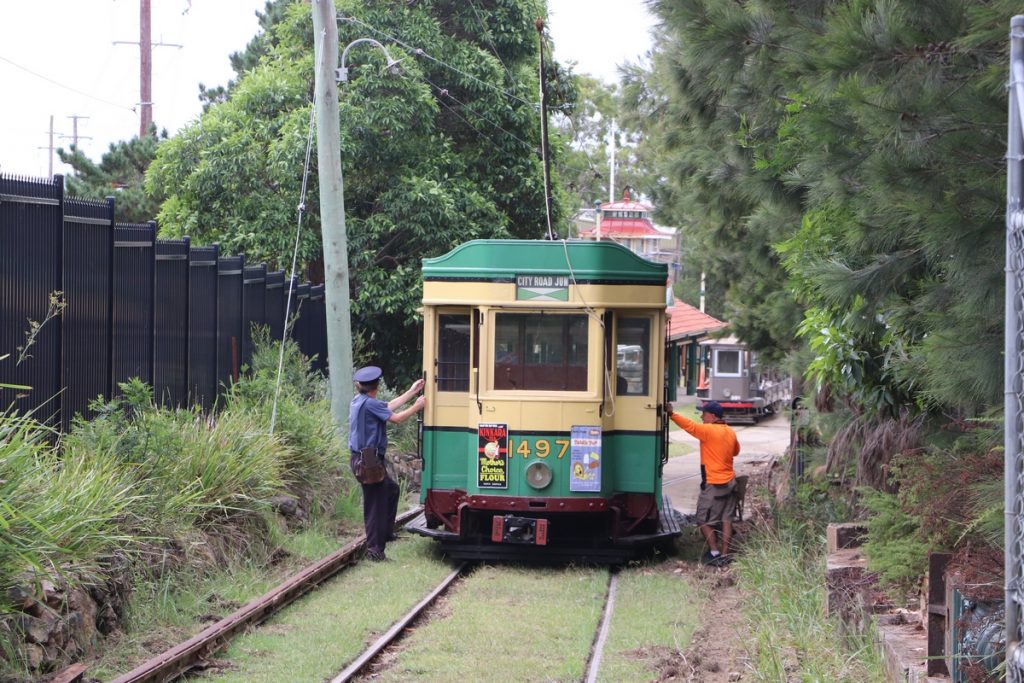
P1497 returning to the depot after the last run.
Saturday 16th of March 2019
Rails freed up – tie bars unbolted and all spikes pulled out along both sides of the worksite. Much rain slows work.
Wednesday 20th of March 2019
Saturday 23rd of March 2019
The work area was excavated by our regular earth moving contractor. Now the ex Kensington rails will be moved in, aligned and leveled. At lot of the spoil was taken to TAFE crossing and used to build up the ground alongside the new concrete track there.
Saturday 30th of March 2019
The weather has already conspired to delay work on this project. On this day the perway crew should have been dragging rails into position and starting with gauging and leveling, instead rain the day before and on Saturday itself made the entire site one large muddy hole. Run off from the railway scoured out the excavation along the upper part and filled the lower part of the excavation with what amounted to quicksand.
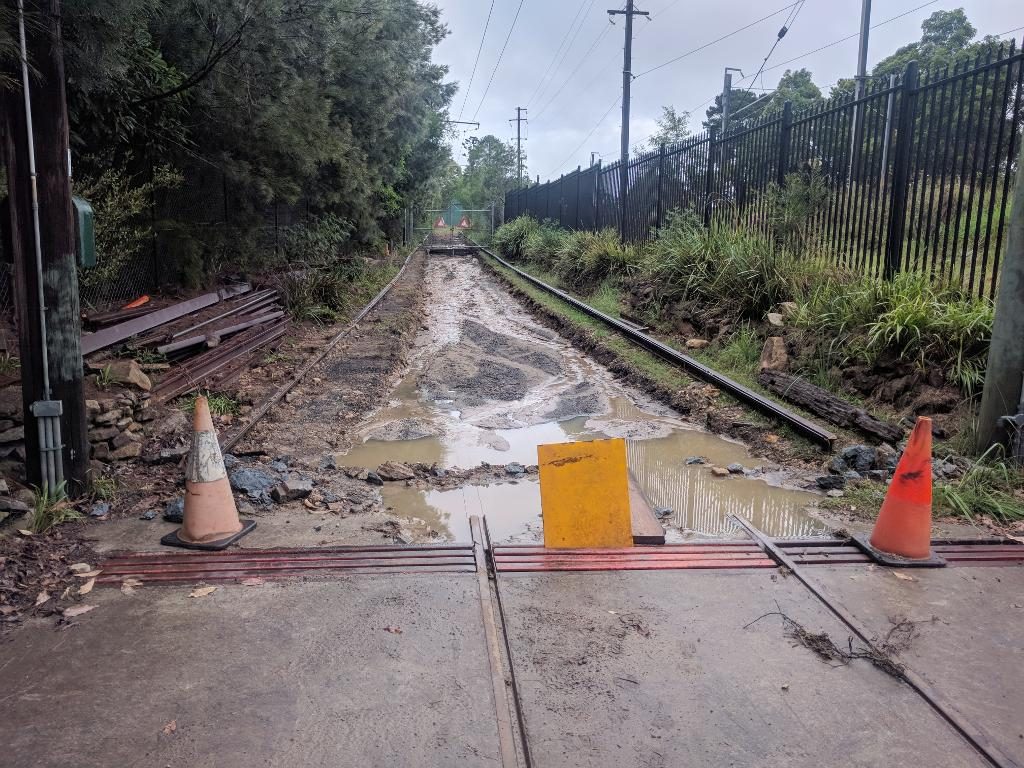
Saturday 6th of April 2019
The rain stopped and the site dried out, so the more work was able to be done. ‘Tidy up’ work with the excavator and the rails laid out for the next step.
Wednesday 10th of April 2019
Track construction finally started – the rain stayed away allowing rail welding to start
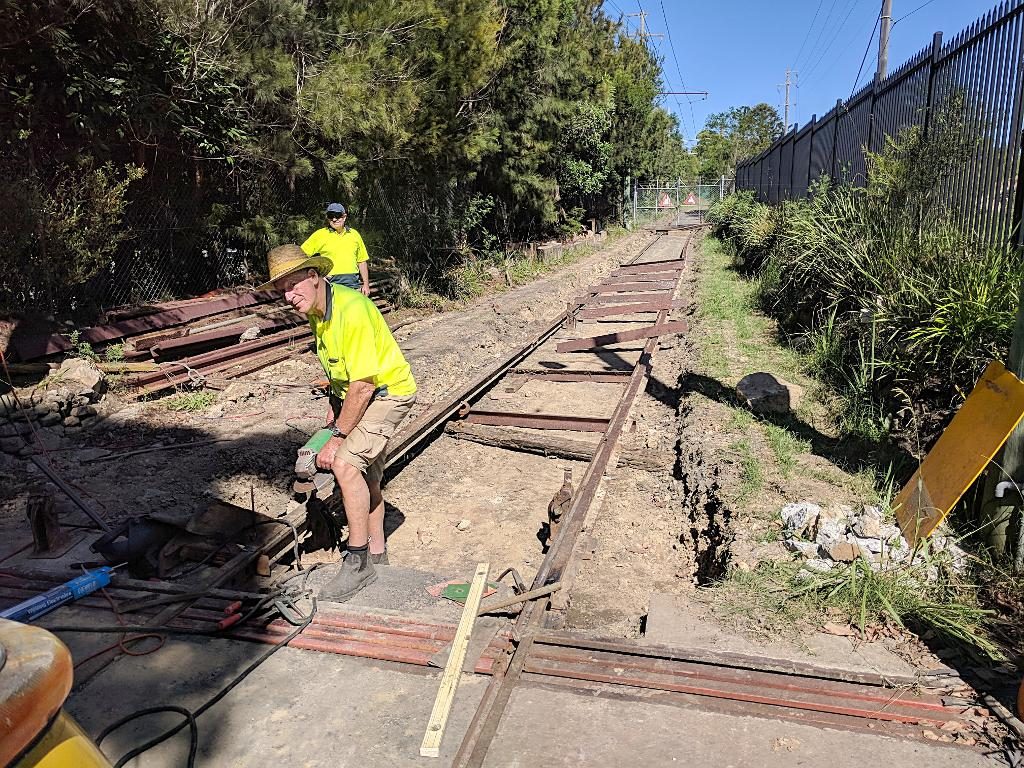
Saturday 13th of April 2019
The welding of ‘sleepers’ started along with initial leveling.
Wednesday 22nd of May 2019
After many weeks of work welding, aligning, levelling and generally getting every thing as perfect as we can, the first concrete arrives. The concrete, a small amount of surplus was used to ‘lock in’ the first 3 metres of track by concreting in the ‘cess’ on each side. The cess is done first as it will allow the truck to back further up the line to place the next load – and also allows the form-work to be moved along at the earliest opportunity.
Photos by Martin Pinches
Saturday 25th of May 2019
A load of purchased concrete. Another 3 metres of track ‘locked in’ and 3 metres finished off.
Photos by Matthew Geier
Wednesday 29th of May 2019
A load of surplus donated concrete. This was used to ‘backfill’ the 4ft of the rails concreted the previous Saturday.
Photos by Martin Pinches
Saturday 1st of June 2019
Another 3m of track locked in. Before each cess pour, the track is resurveyed to ensure it’s still in line and level and any needed corrections made. We soon may re-open enough of the track to enable a ‘headshunt’ so that traffic cars don’t need to use the tight curve of Cross Street.
Photo by Michael Hatton
Saturday 8th of June 2019
It’s been a wet week at Loftus and little progress could be made on Wednesday, but the weather changed enough to allow another 4m of purchased concrete to be placed locking more track into position. The formwork is now past the gate.
Photos by Matthew Geier
Saturday 15th of June 2019
A full load of purchased concrete and later in the day some surplus for a total of 8m3. The track is now ‘locked in’ to the gate and is approximately halfway. The first section will be available for use as a ‘headshunt’ in the next week after the concrete cures and the chief engineer is happy.
Photos: Matthew Geier
I shot a small video of the action – be warned the noise of the concrete vibrator is jarring.
Photos by Matthew Geier
Wednesday, June 26th
About 0.8 m3 of black-pigmented surplus concrete was delivered early and placed in four foot below rail foot level.
About 1.1 m3 of normal surplus concrete was delivered late and placed above the previous delivery.
South of the gate another track drain frame and formwork has been constructed. Hopefully, this will trap a lot of the runoff from the rail corridor that flows down this hill.
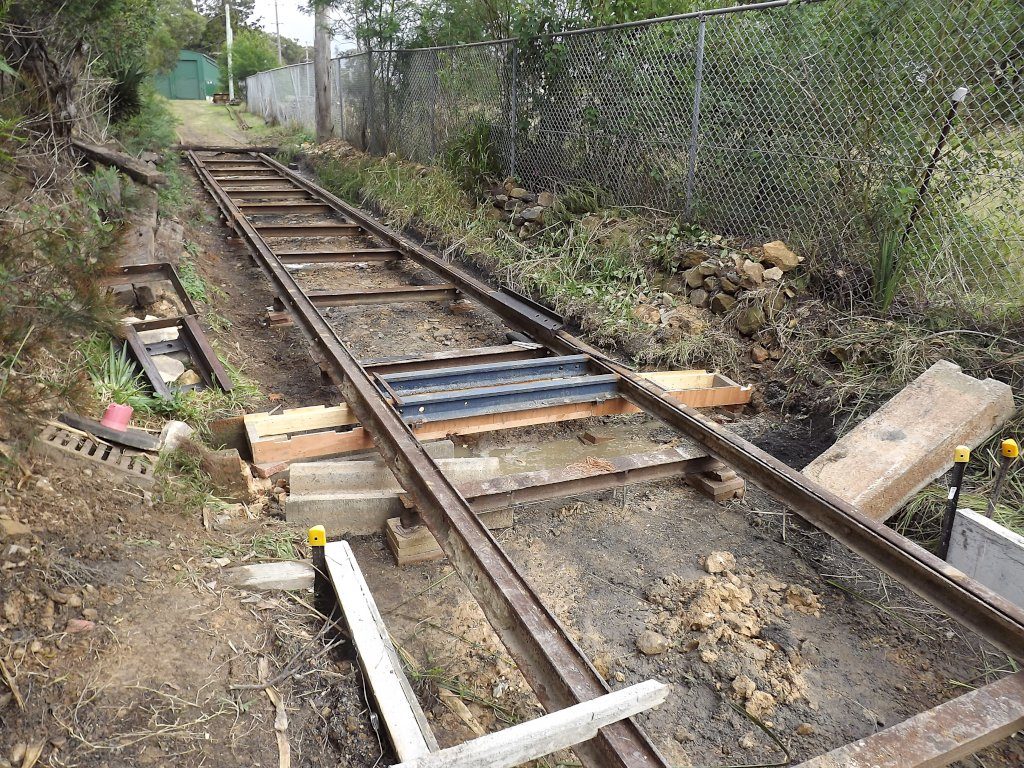
Track drain being fabricated 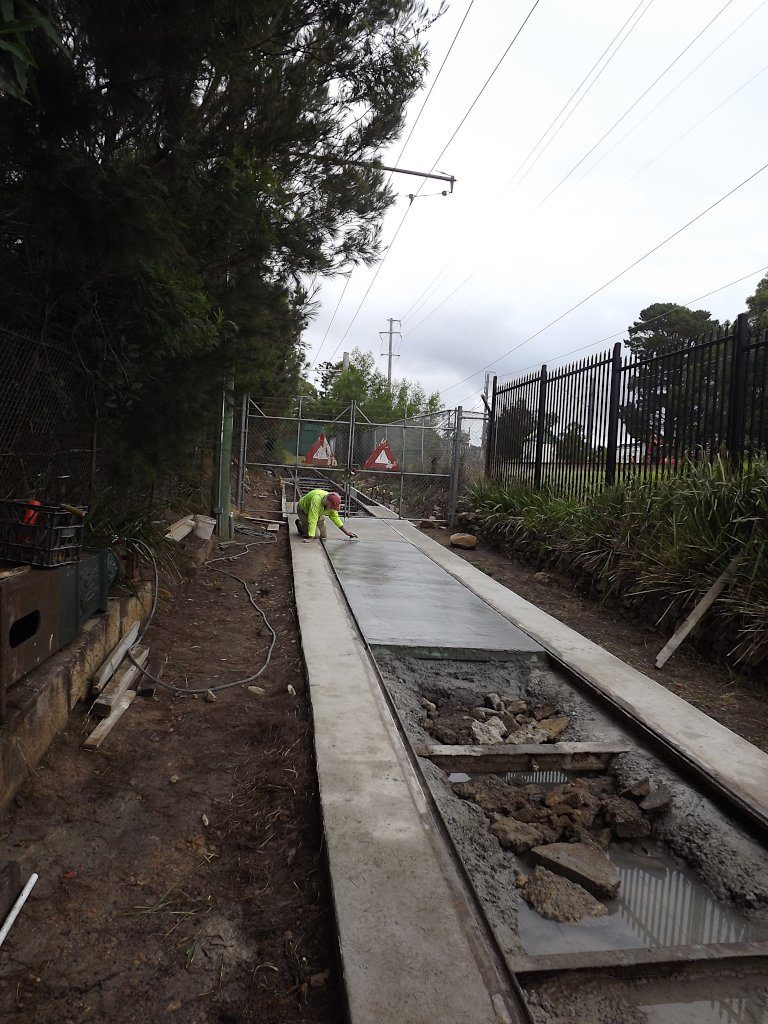
Finishing the 4ft near the gate
Photos by Richard Clarke
Tuesday, July 2nd
A lot of the welding has been done of an evening. Here a ‘ding’ in the rail head from when the rail was removed from Anzac Pde with rock breakers has been welded over and is now being smoothed back.
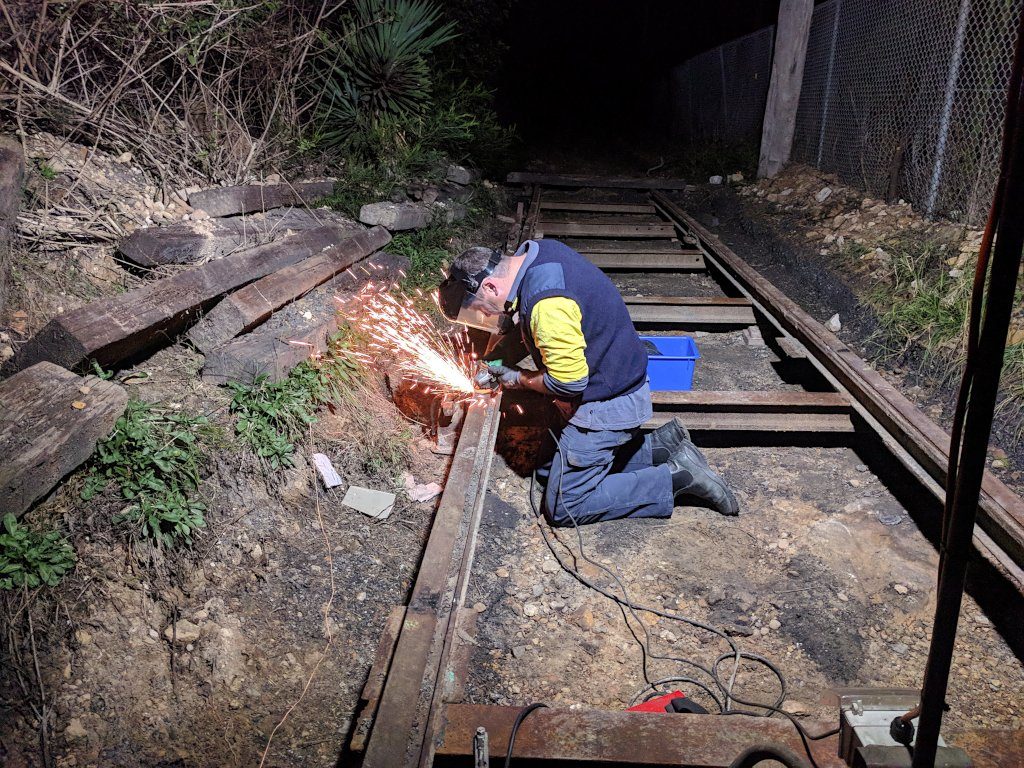
Night works – welding and griding of rail defects. When removed from the road some minor damage to the rails occured. This is being patched up.
Photo by Matthew Geier
Saturday, July 6th
Another 3m3 of concrete and a small amount of surplus. This has the rails ‘locked in’ to the 2nd track drain and is about 3/4 of the way for the current project. The track inside the gate has now been fully concreted in the ‘4ft’ as well.
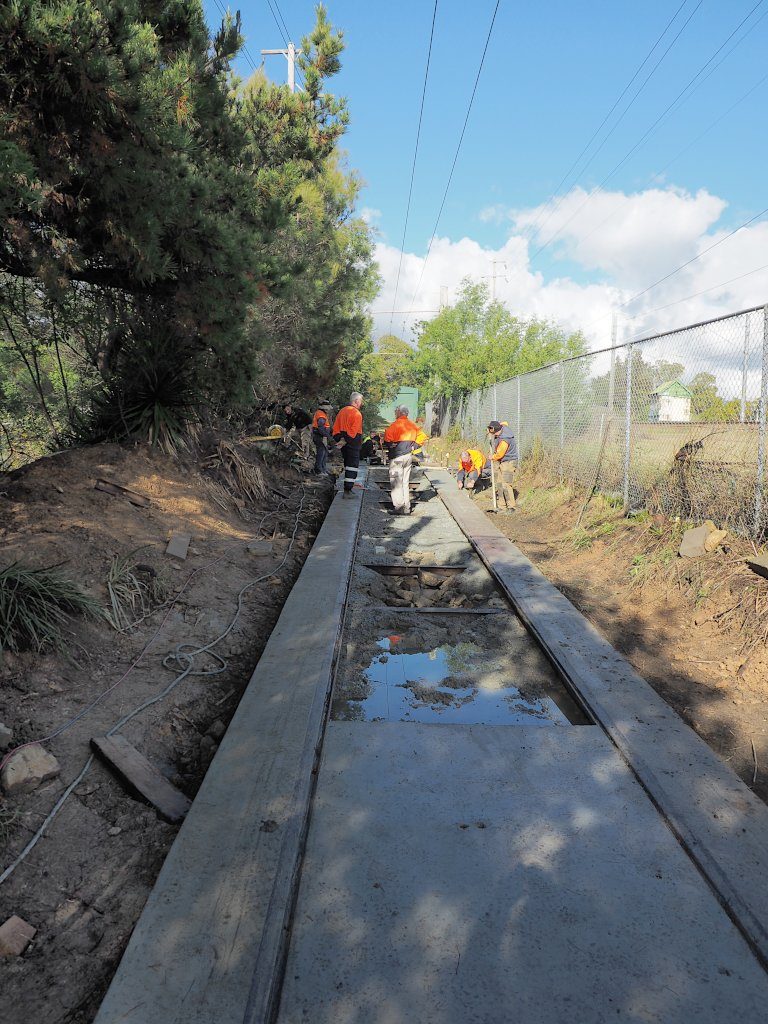
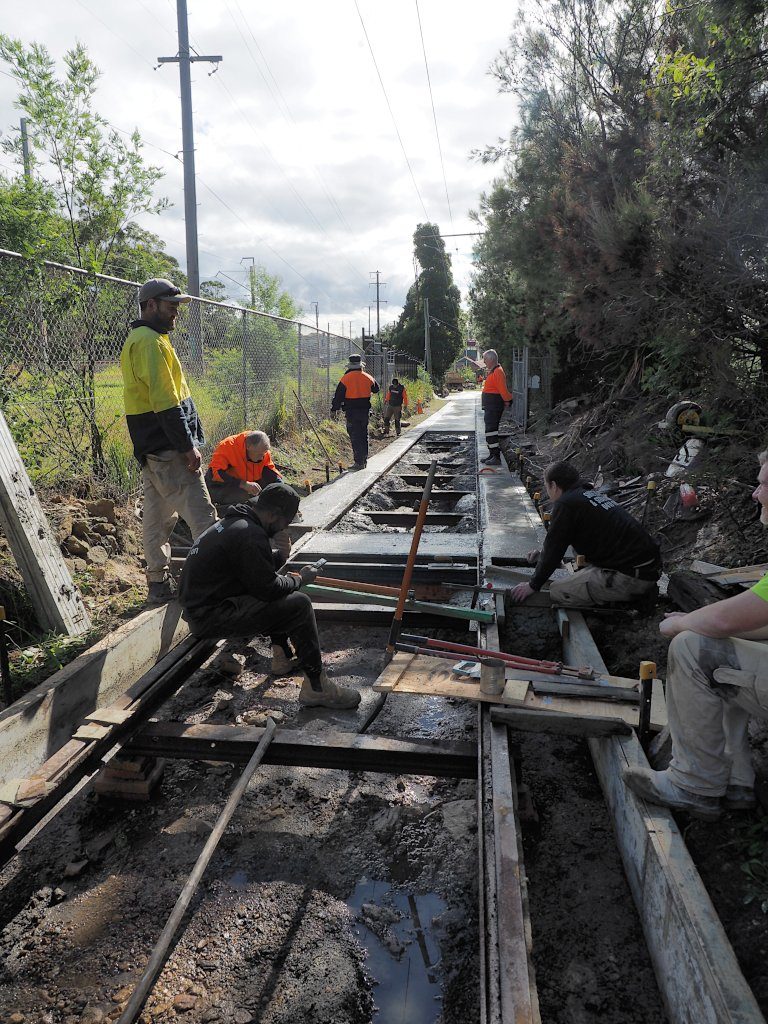
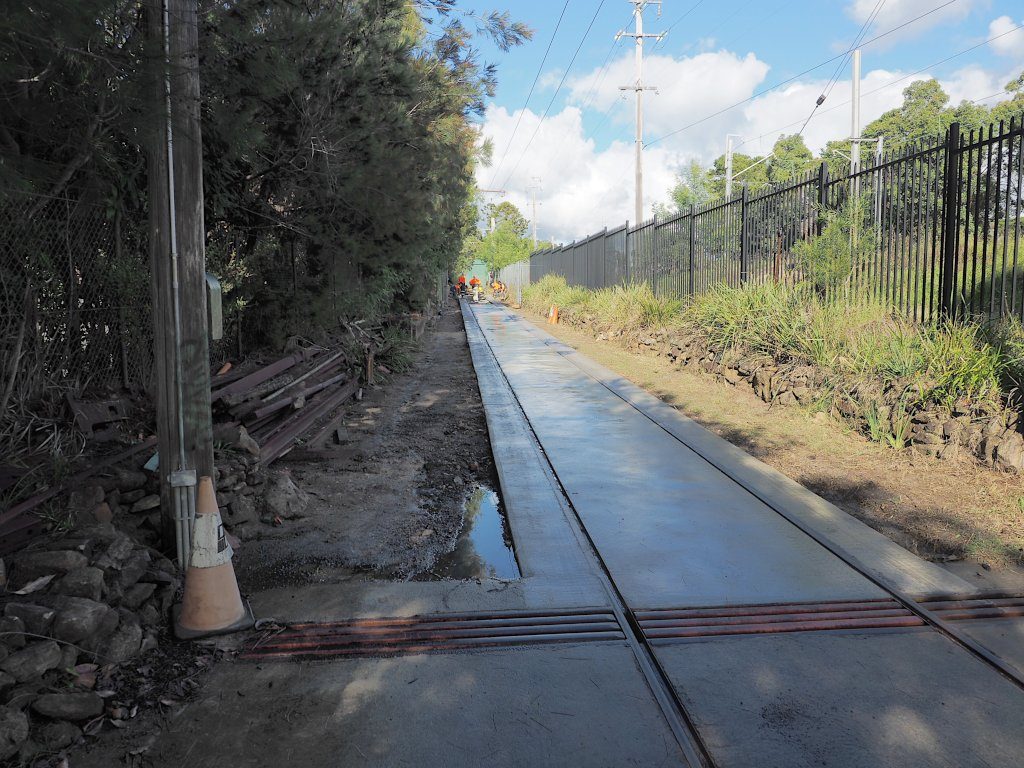
Looking up the hill from ‘Depot Junction’. Approximately 36m (of 67m) is now completed.
Photos by Matthew Geier
Wednesday, 10th July
Two small loads of surplus kept the Wednesday track crew busy. 4ft now complete to the track drain. The gap is closing.
Photos by Martin Pinches
Saturday, July 13th
3m3 of purchased concrete, and later approx 2m3 of surplus arrived.
This finished the 2nd track drain and approx 4 linear metres of track. Only about 3m of the track is left to the concrete and then the new track will be joined to the remaining old track. The 4ft will have to be completed before the track is handed back to traffic operations.
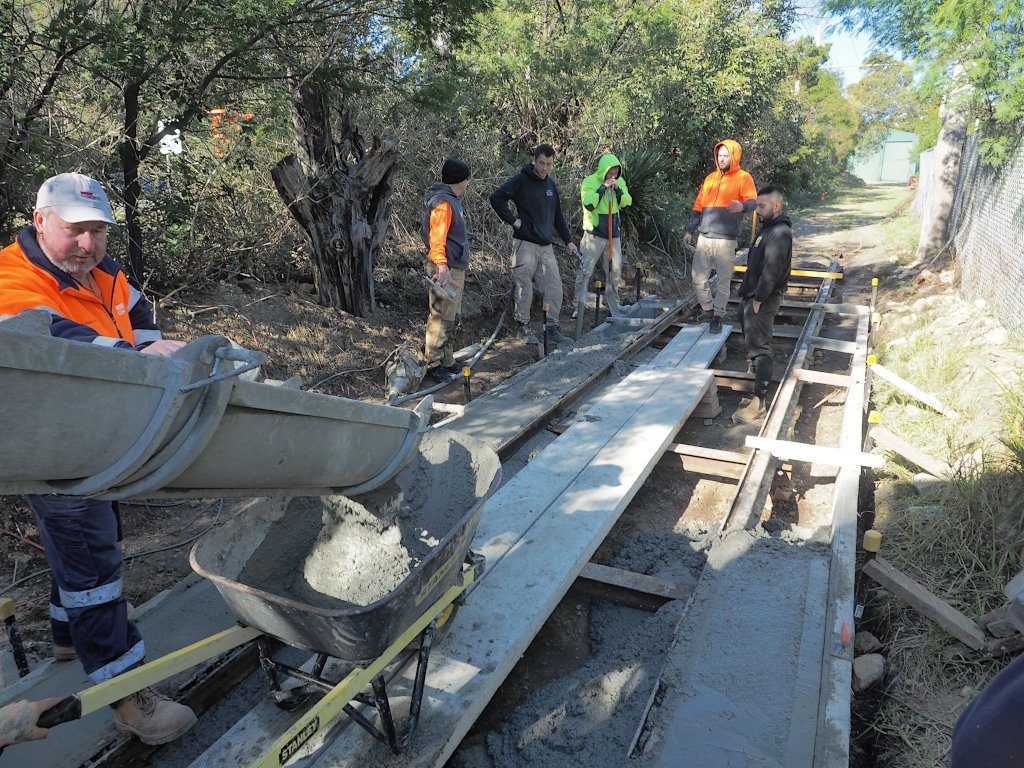
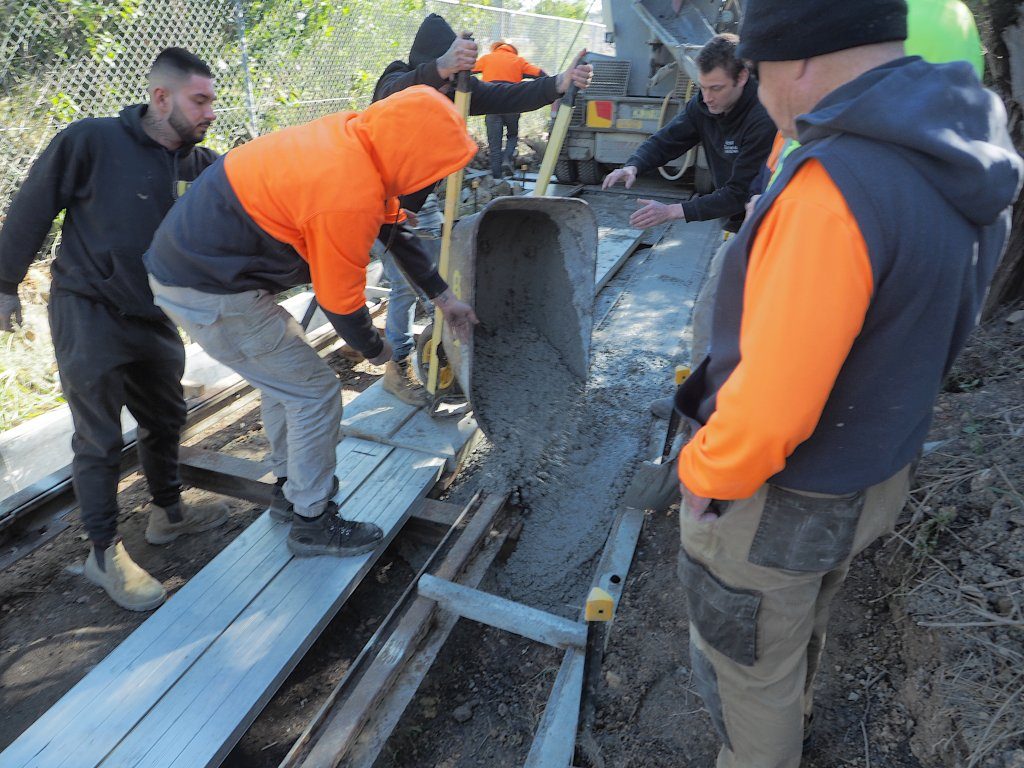
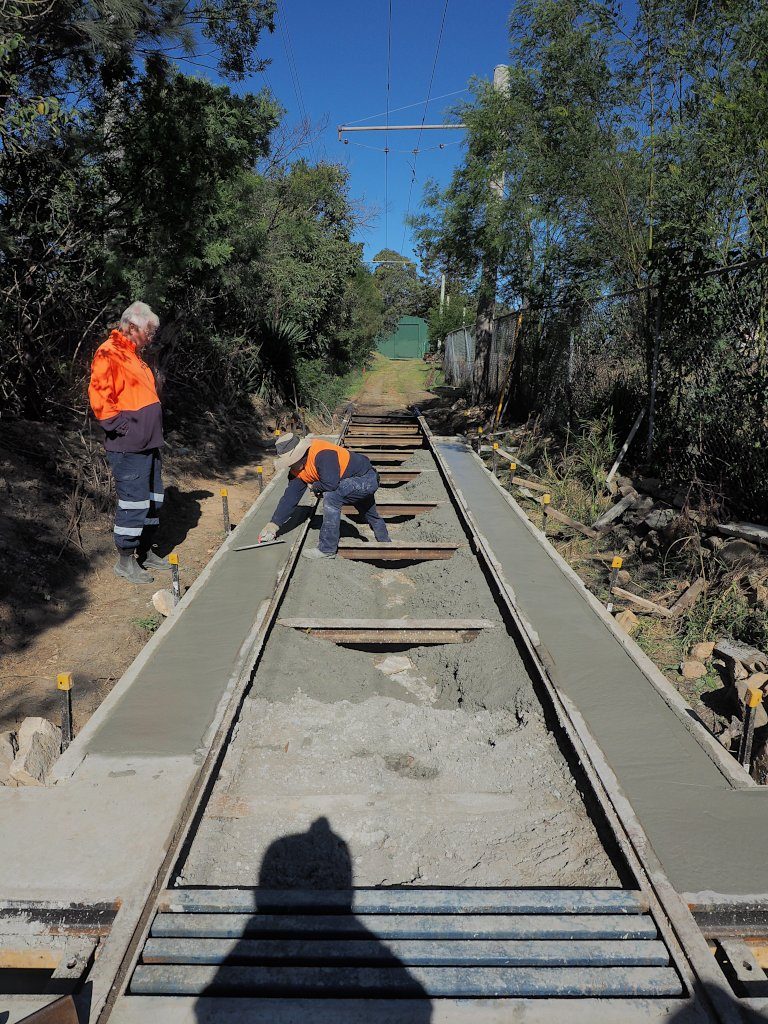
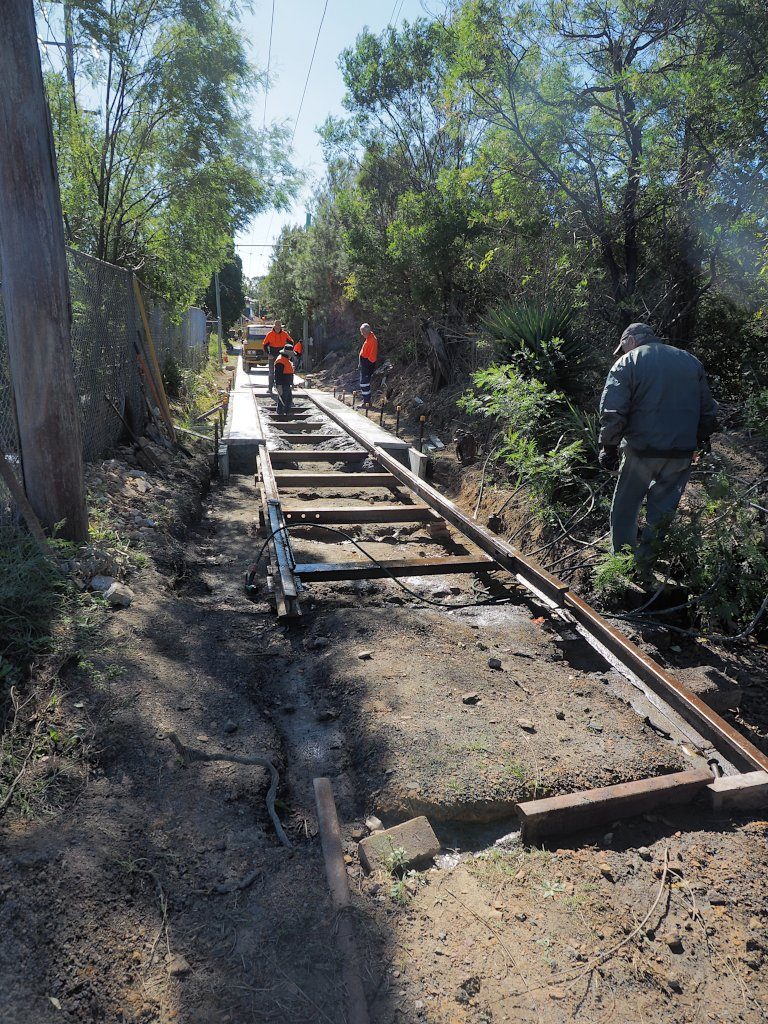
Getting closer…
Photos by Matthew Geier
Saturday, July 20
A major milestone today – the track was concreted up to pole 28. This is as far as the mass concrete track goes in this project. A small amount of ‘4ft’ still remains to be filled in, but the rails are now ‘locked’ into position.
There is a level mismatch between the concrete track and the old ‘dirt’ track, and approx 10m of the existing track will be raised and repacked to meet the concrete track.
A future stage will see more of this area concreted and a consistent grade kept running all the way down the hill.
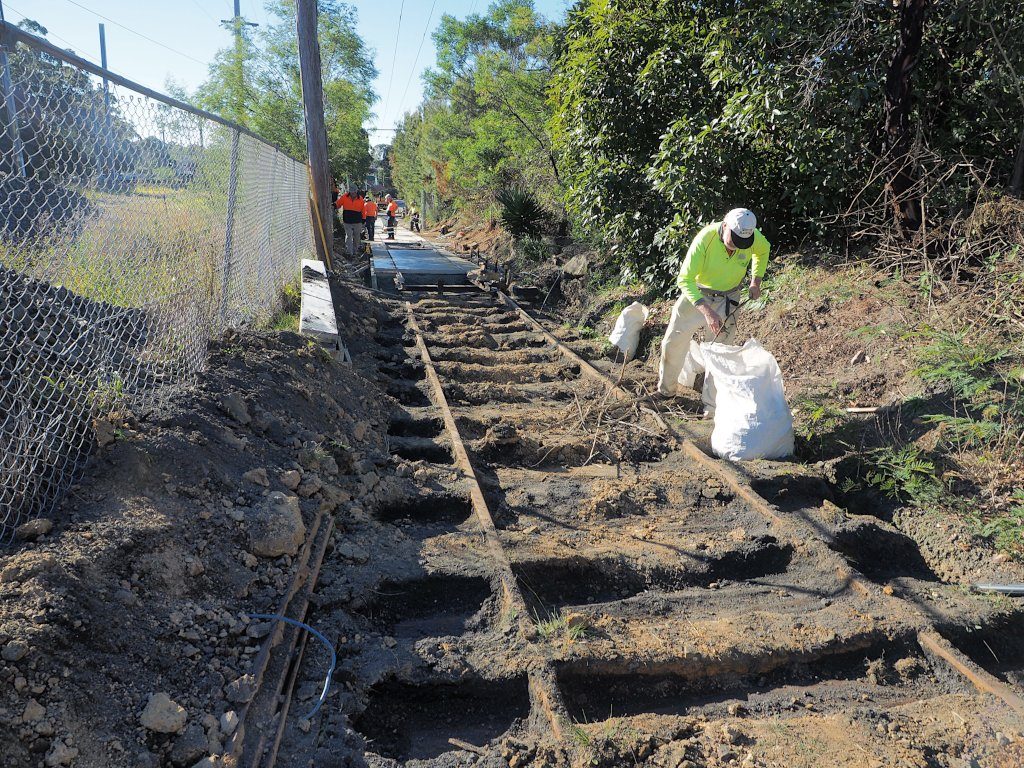
The old track being readied for lifting 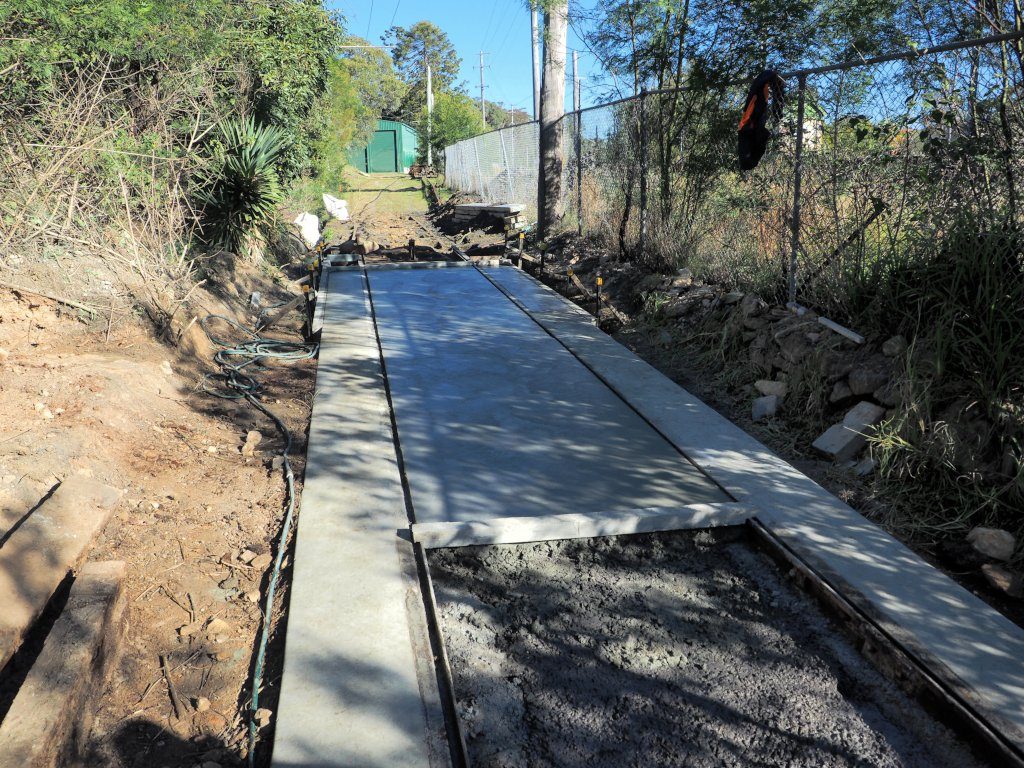
Concrete to pole 28 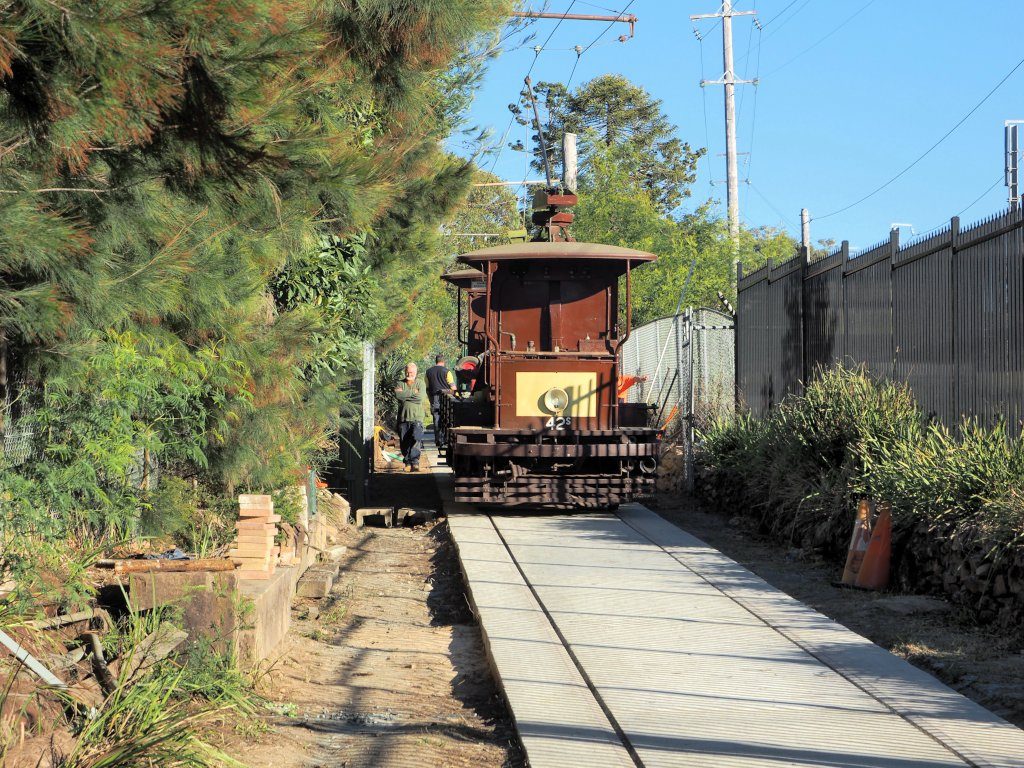
Balast Motor 42s on the new track.
The track gang are packing up for the day and loading
tools onto 42s
Photos by Matthew Geier
Saturday, 27th July 2019
The connecting track was lifted and the western rail was connected. The eastern rail was drilled but the fish plate was not installed. The track still needs ‘packing’ properly support the sleepers at the new levels.
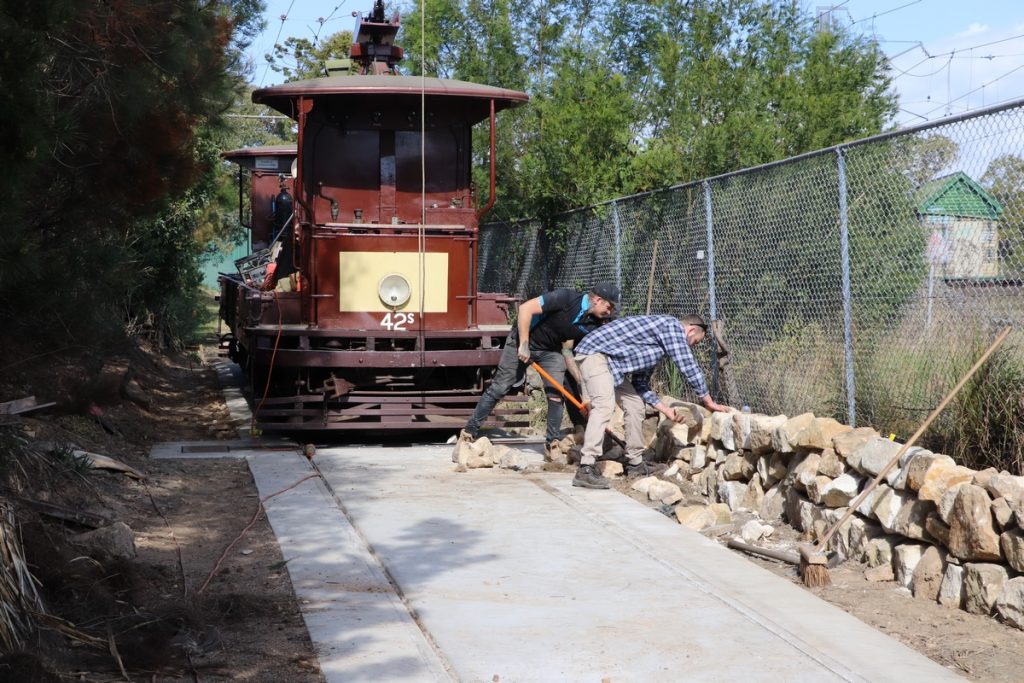
Rebuilding the rock wall along the railway boundary 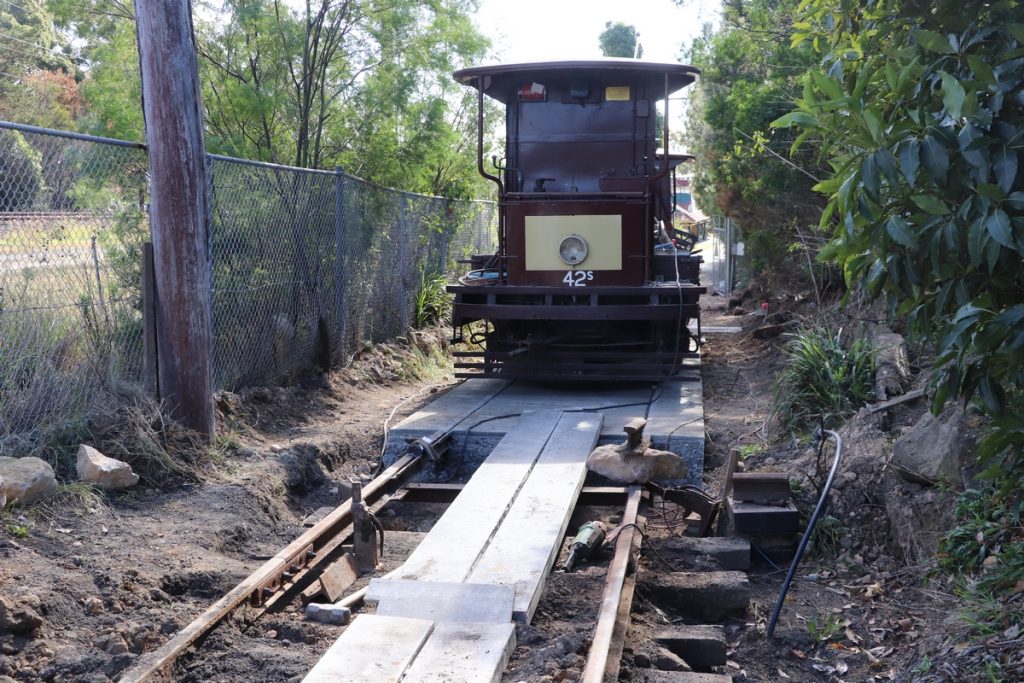
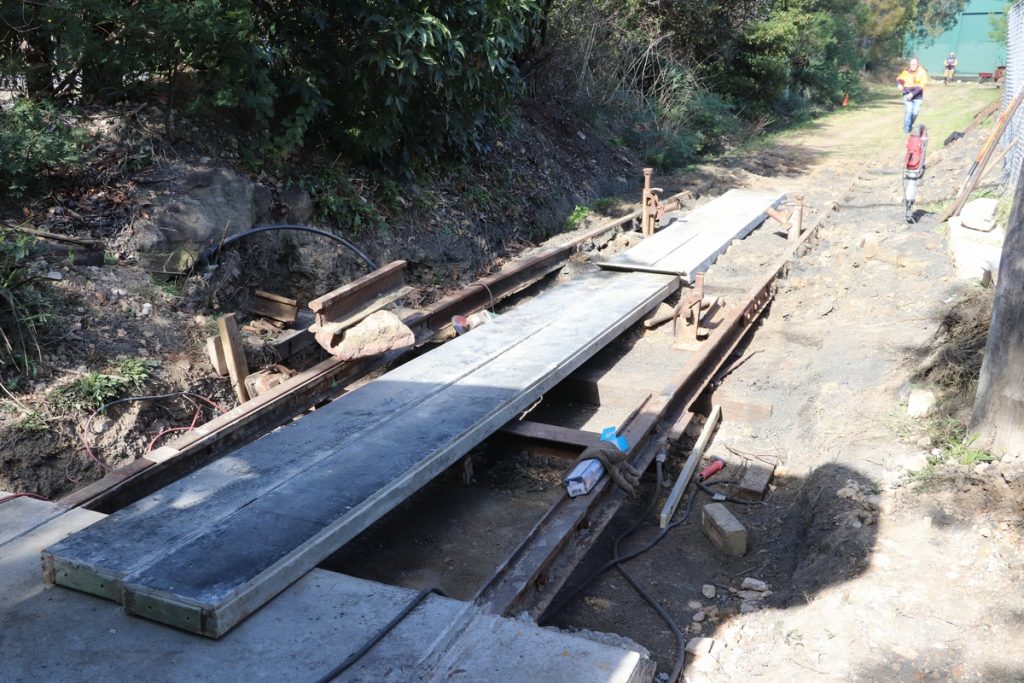
Western rail connected
Photos by Martin Pinches
Saturday, 3rd August 2019
Final connections made and transition lifted and packed. However, it’s been decided a small amount of extra concrete is required to support the transition.
The local trees have been trying to reclaim the space, so an extensive pruning was undertaken and the cuttings mulched with the ‘PTO’ mulcher.
Photos by Matthew Geier
Wednesday, 7th August 2019
Final concrete pour. The transition to sleepered track concreted. As soon as this cures, works trams can get into the National Park and prepare the line for the return of passenger trams.
Photos by Martin Pinches
Saturday, 10th of August 2019
Track reconstruction is now complete and track testing was undertaken. Minor finishing work is required before the resumption of regular services. It’s hoped that we will be able to reopen the line to passenger traffic Sunday the 18th.
Photos by Michael Hatton
Wednesday, 14th August 2019
Return to operation of the Royal National Park line approved for Sunday the 18th of August 2019.
Many thanks to the track gang some of who put it quite a lot of hard physical labour to make this happen.
The rails used in this new concrete track once carried trams down Anzac Parade in Sydney’s eastern suburbs and were donated to the museum by the civil construction contractor for the Kensington zone of the new City and Eastern Suburbs Light Rail. These rails will once again carry trams – and it’s possible some of our Sydney trams ran on these very same rails over 50 years ago on their way out to the various eastern terminus of the old Sydney Tramways.
Saturday, 17th August 2019
The last bit of the 4ft was concreted. Now only cosmetic tidy up work is required. (Back fill, planting grass, etc). Full services to the Royal National Park resumed on Sunday the 18th
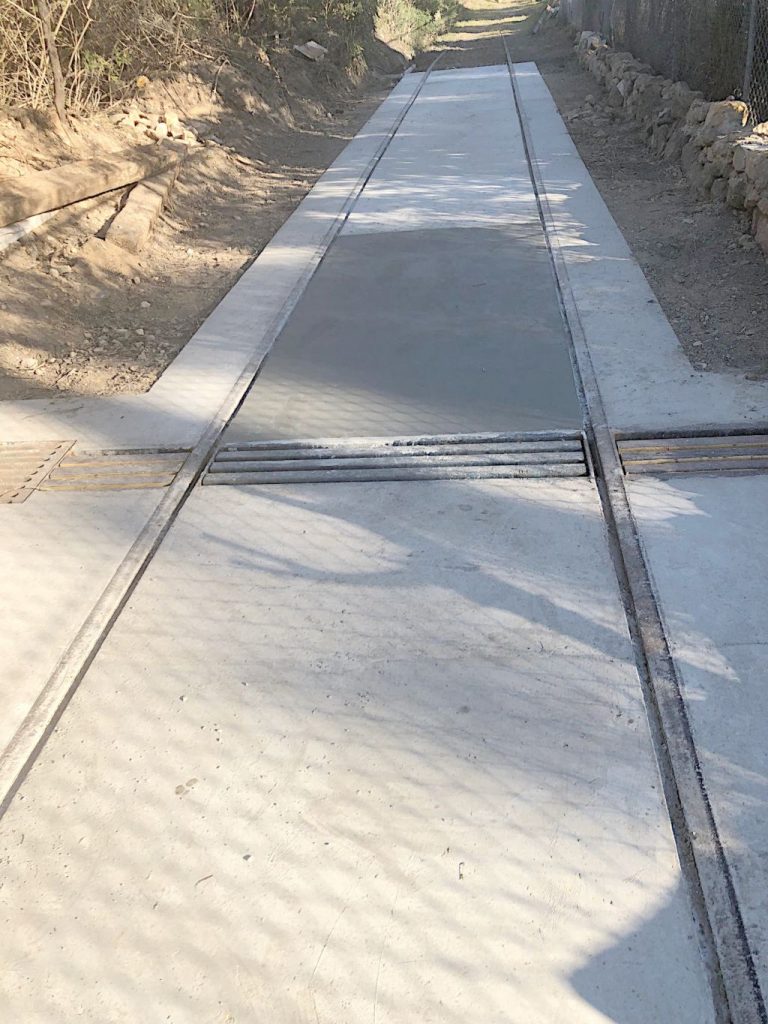
South Hill – last concrete in 4ft place
Photograph by Ian Saxon
Press
The light rail project PR department turned out a press release on the occasion of us re-opening the South Hill track. It took a lot of behind the scenes work on the museum’s part to secure those old rails.
https://sydneylightrail.transport.nsw.gov.au/news/sydney-tram-tracks-come-full-circle
The Transport PR piece then got ‘syndicated’ and appeared in the St George – Sutherland Leader local newspaper.
https://www.theleader.com.au/story/6376228/new-life-for-vintage-tram-tracks/
The PR piece may have turned up in other channels as well.

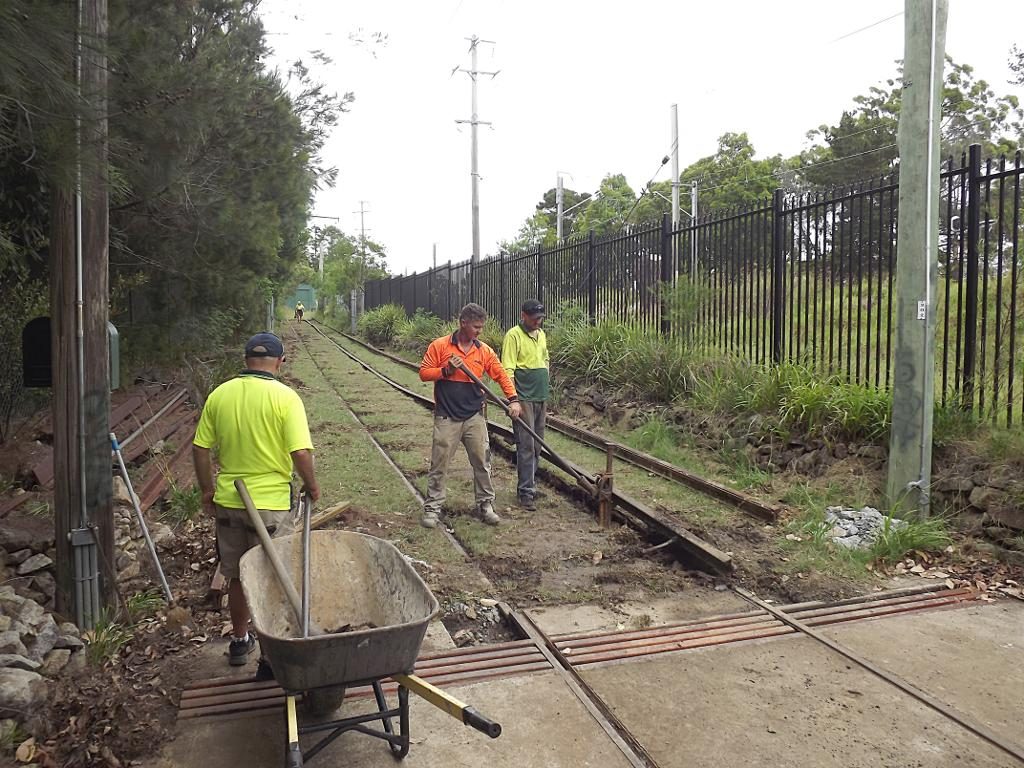
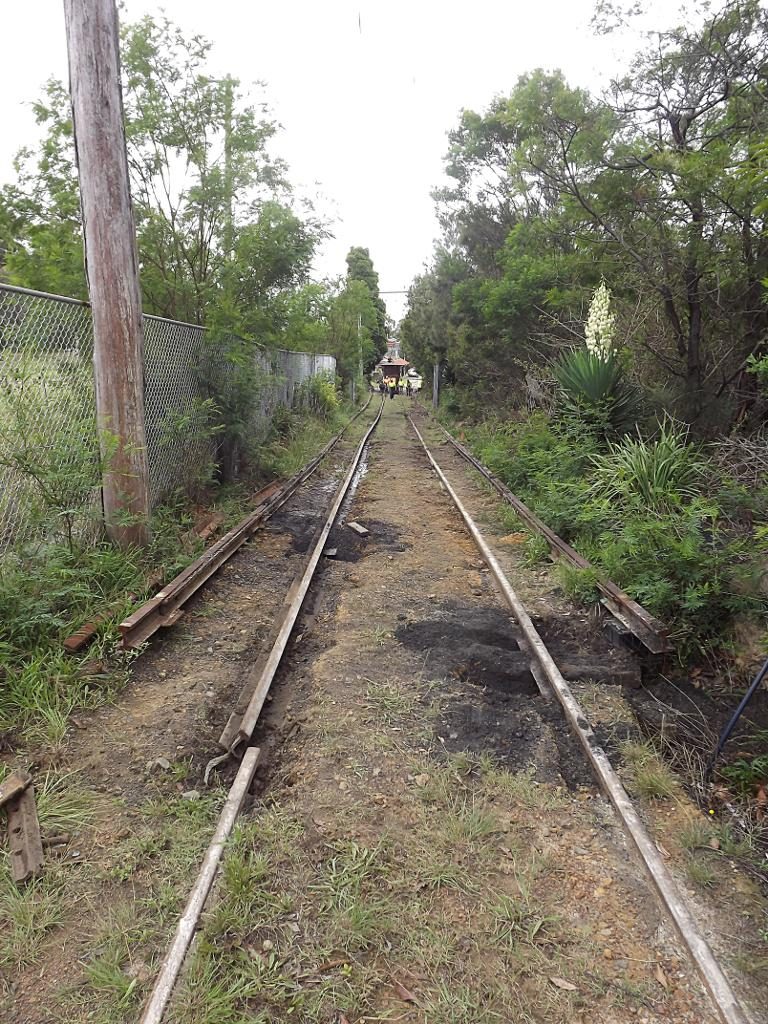
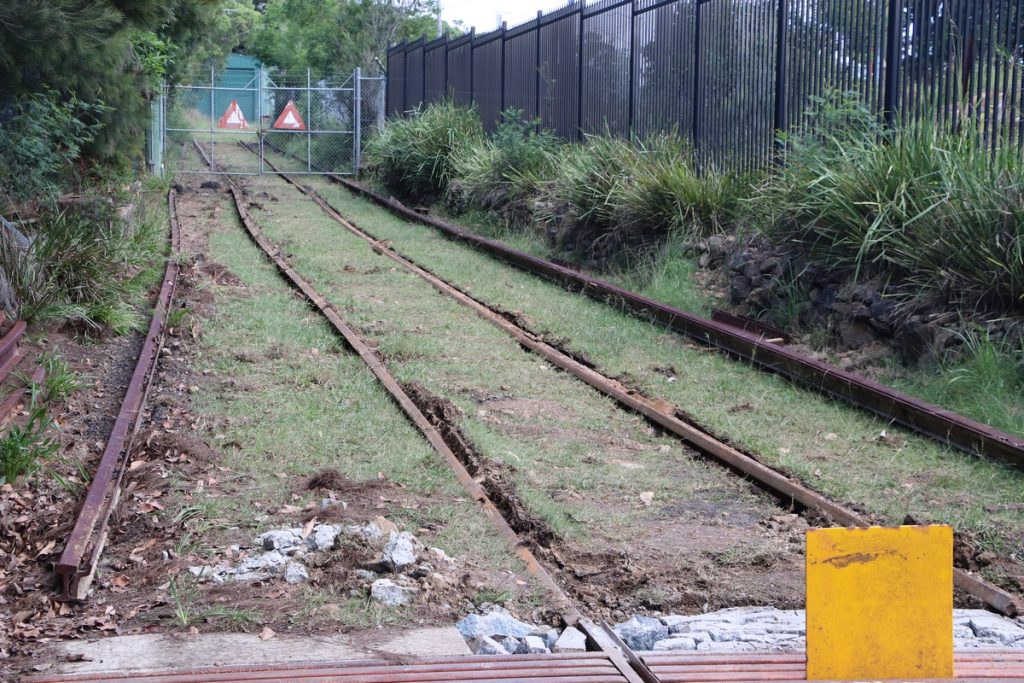
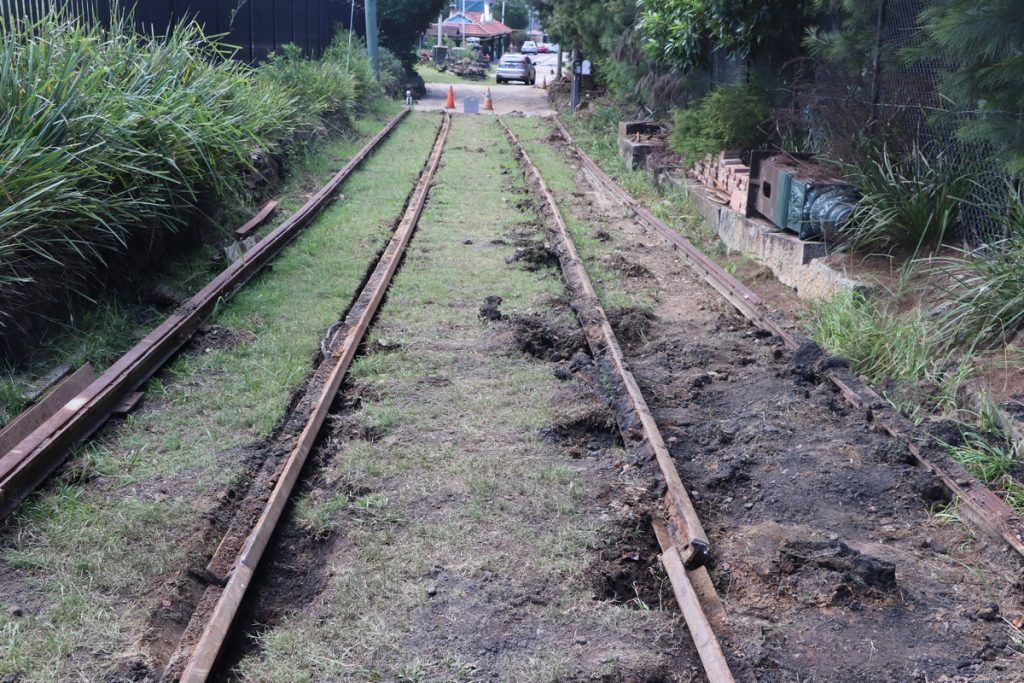
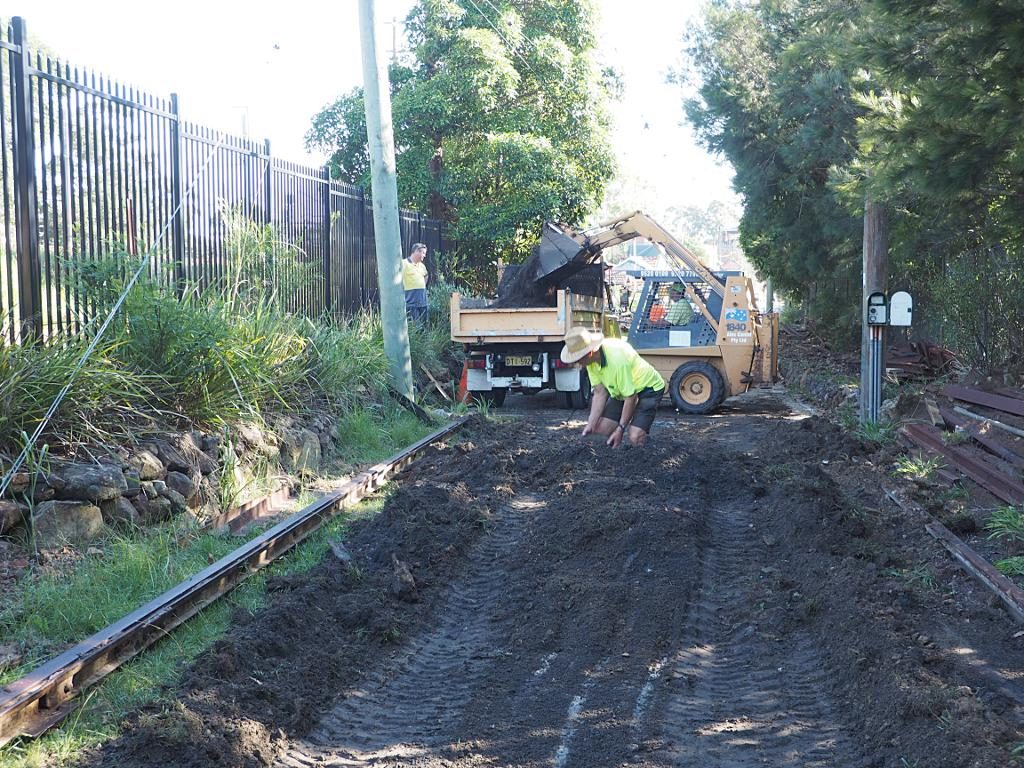
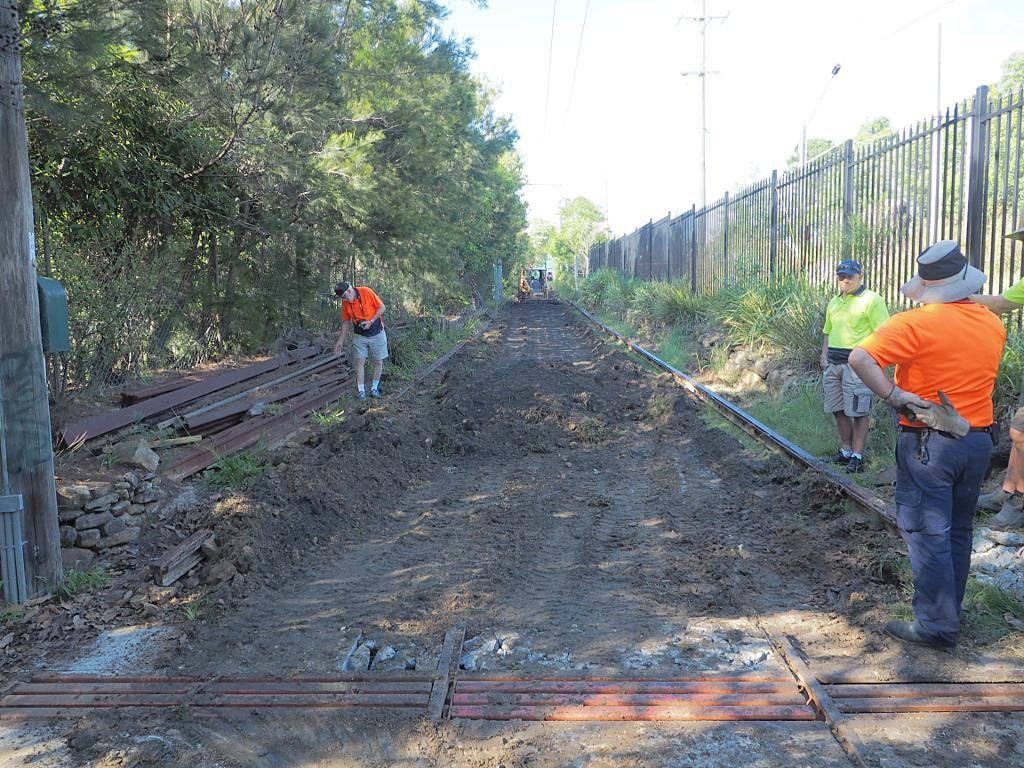
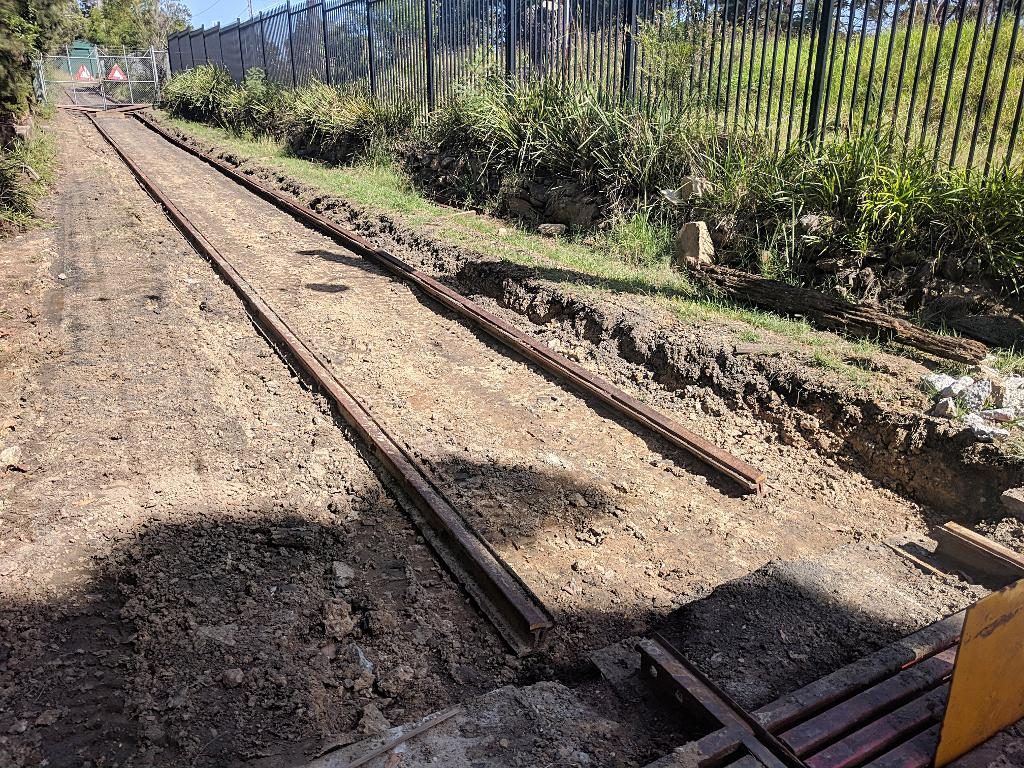
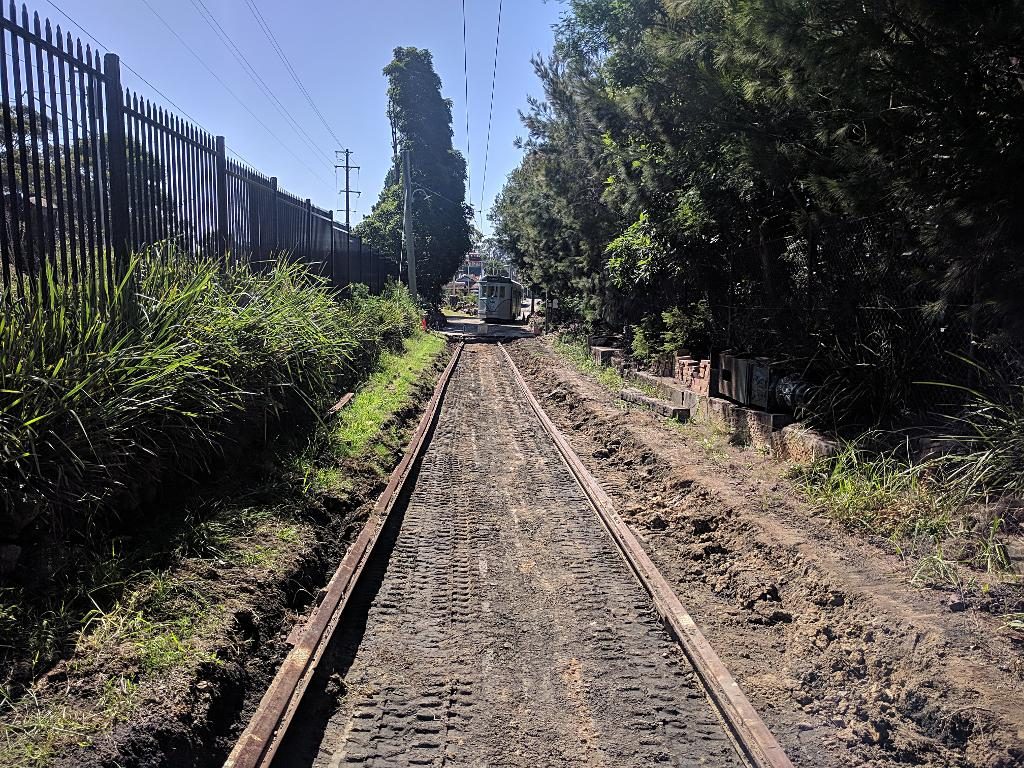
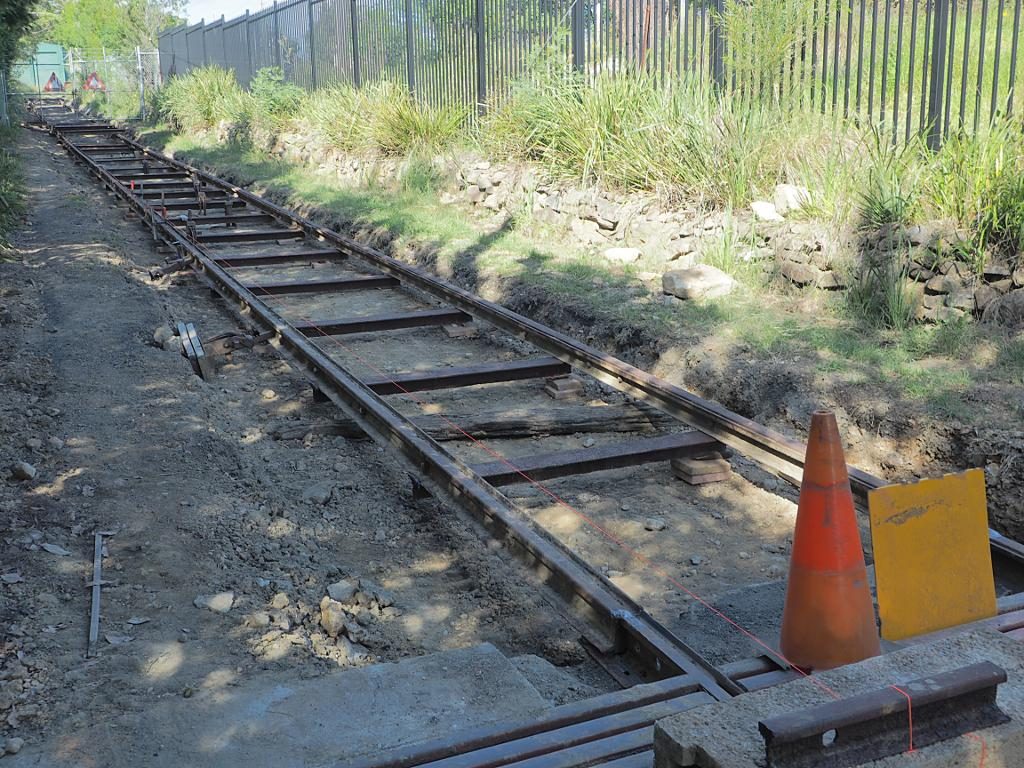
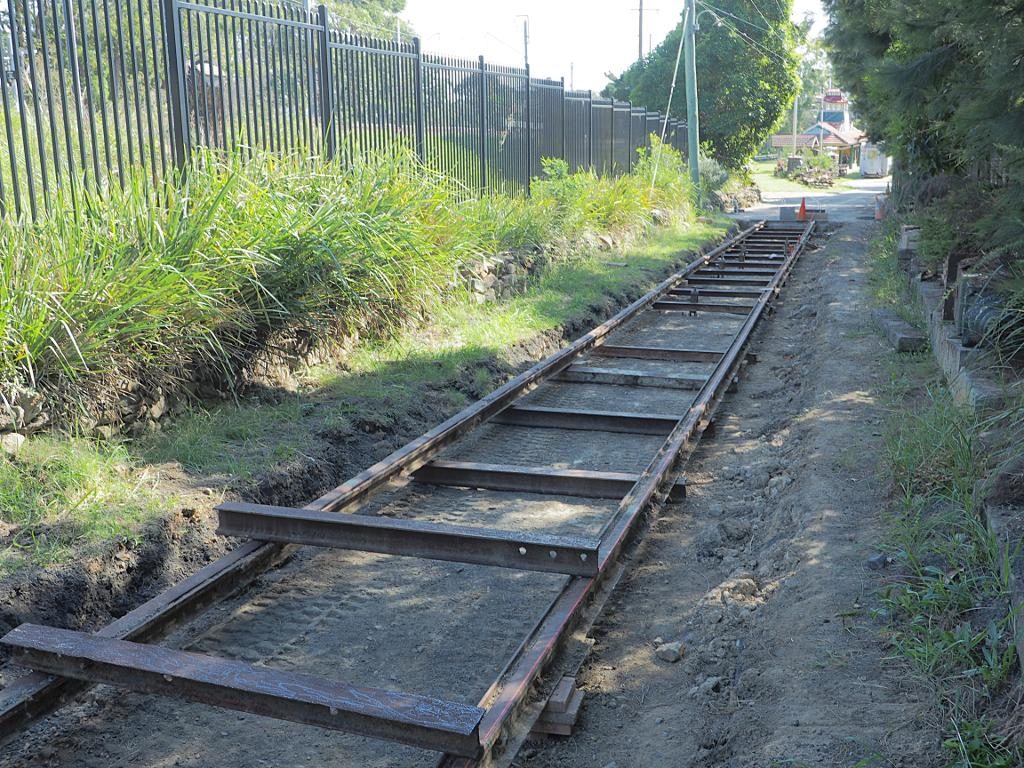
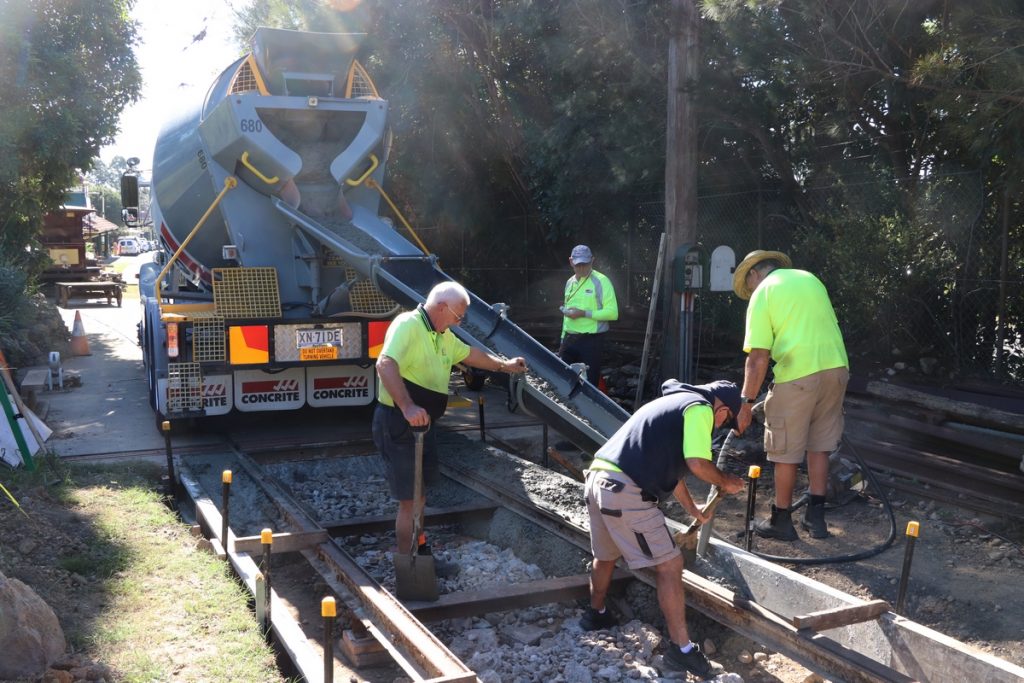
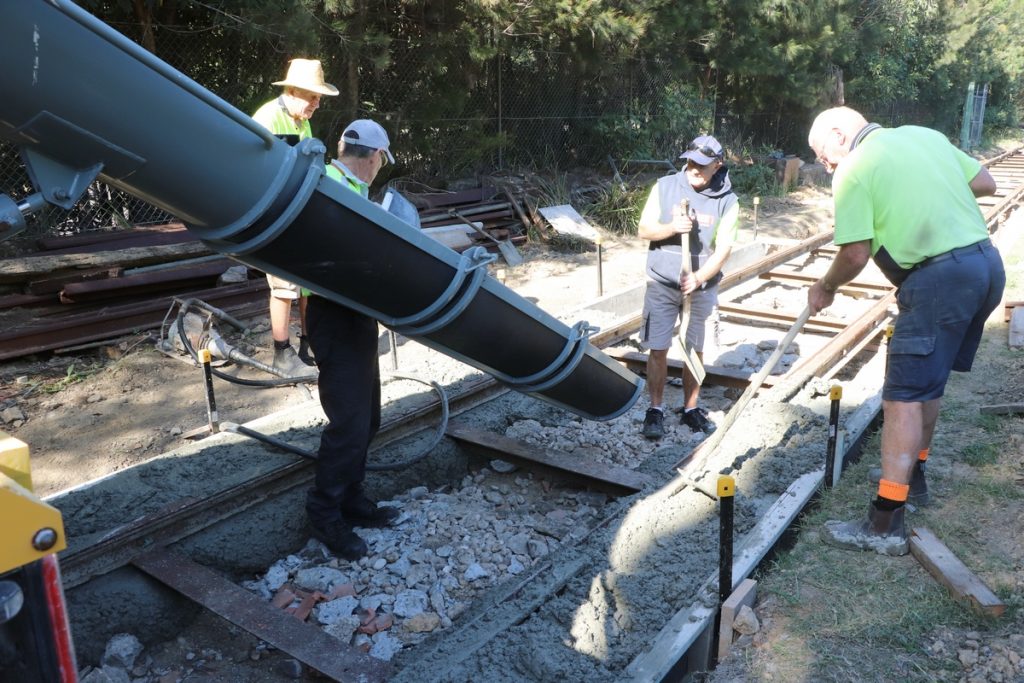
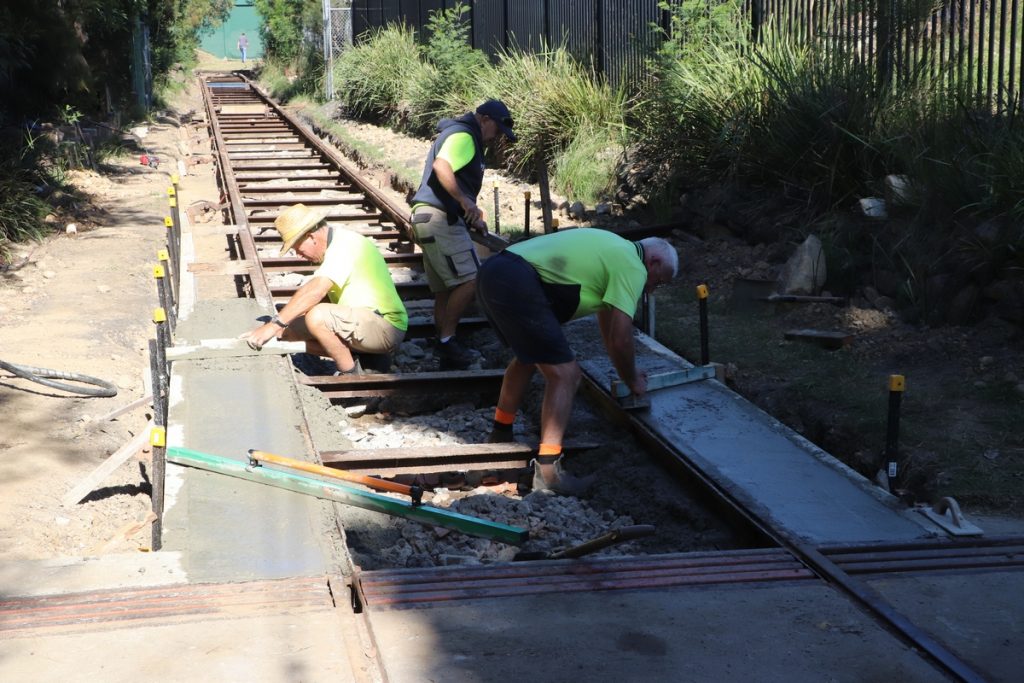
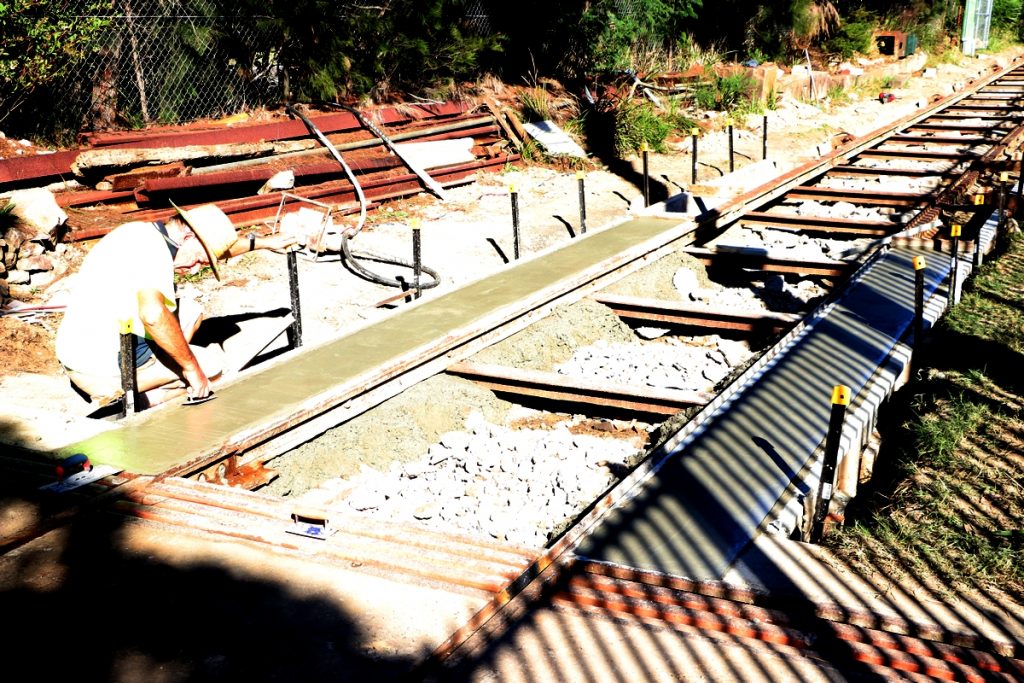
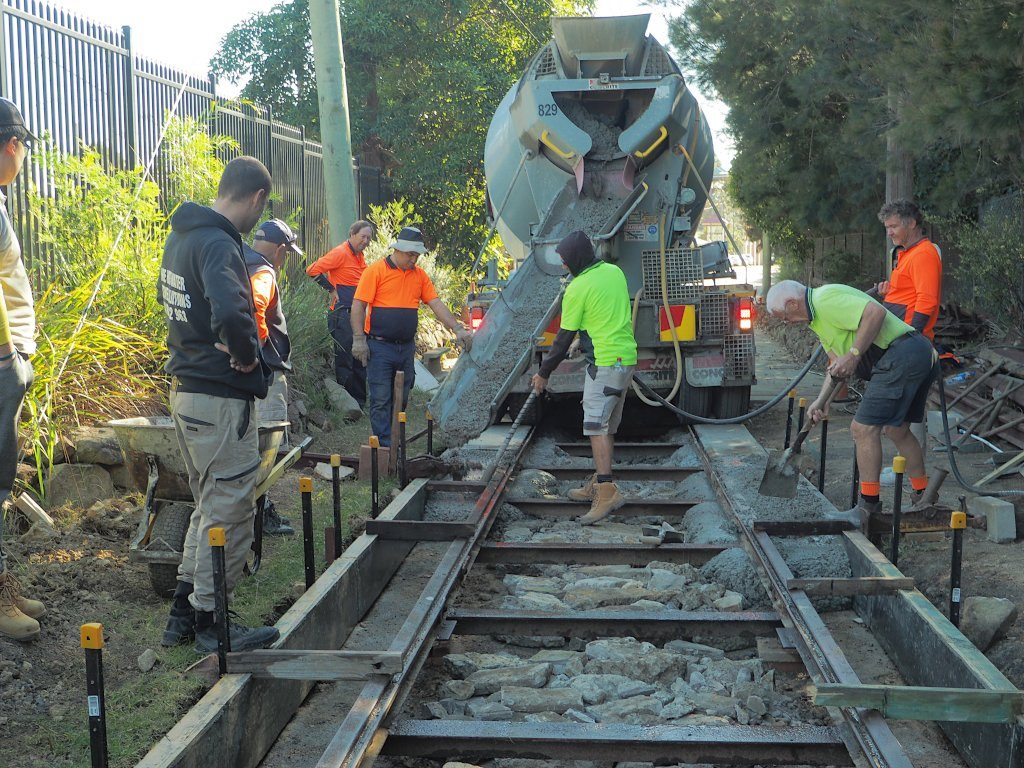
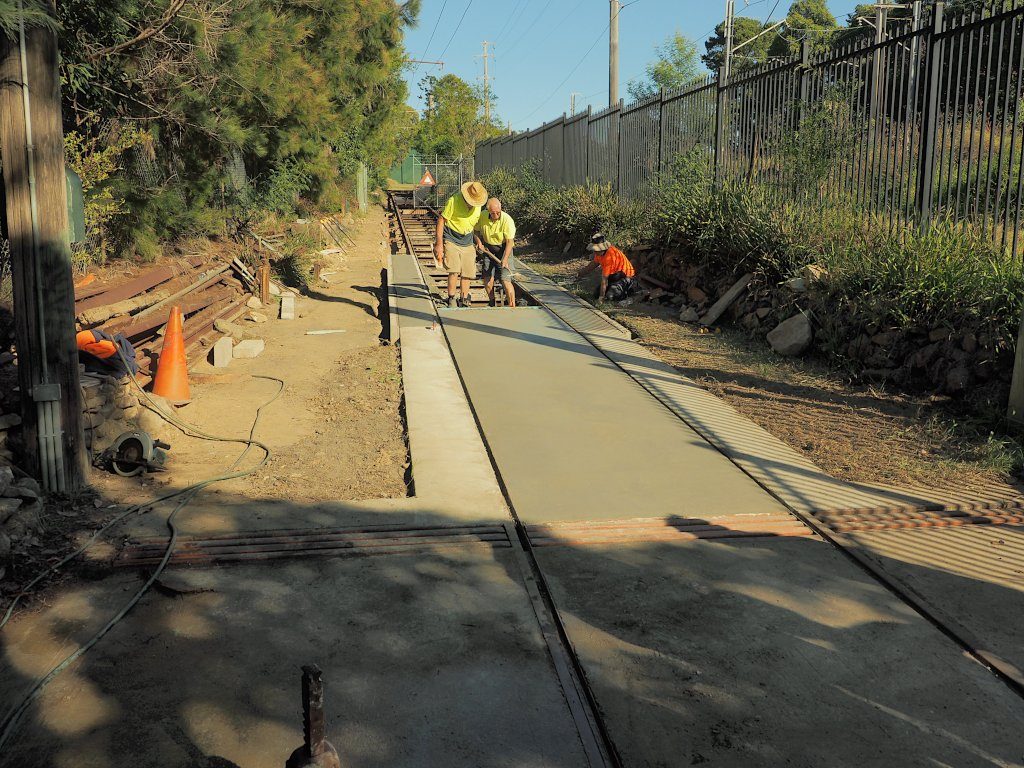
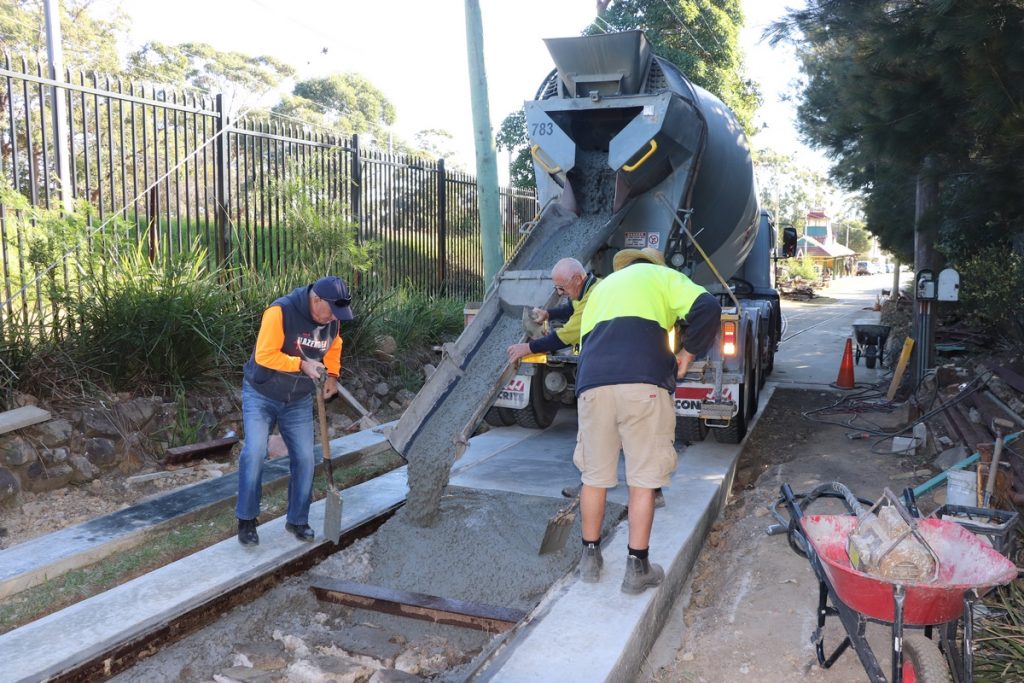
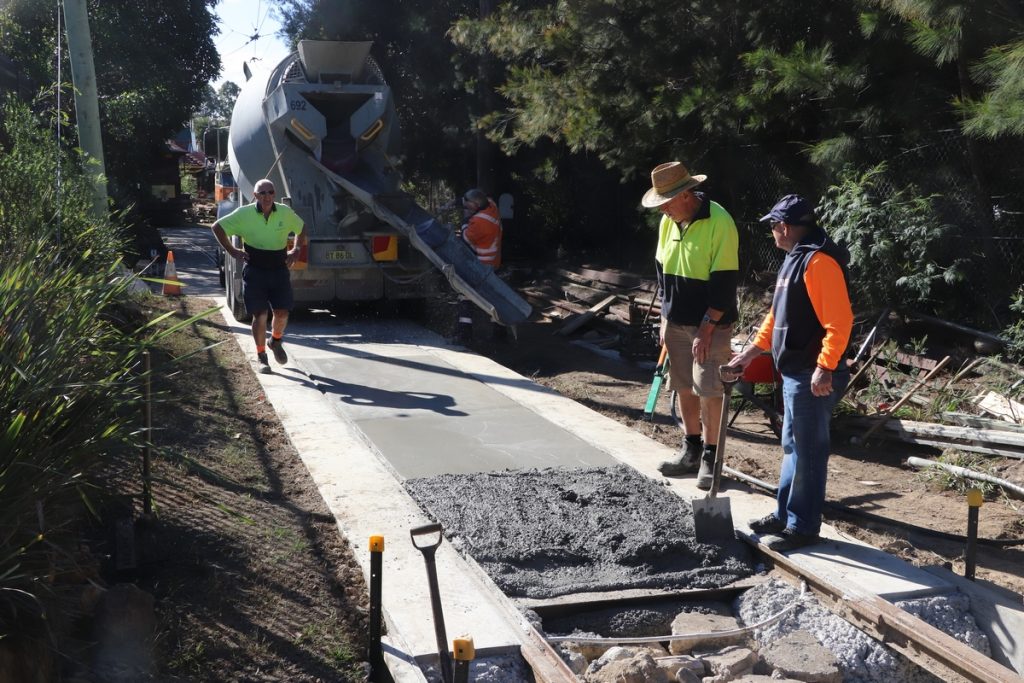
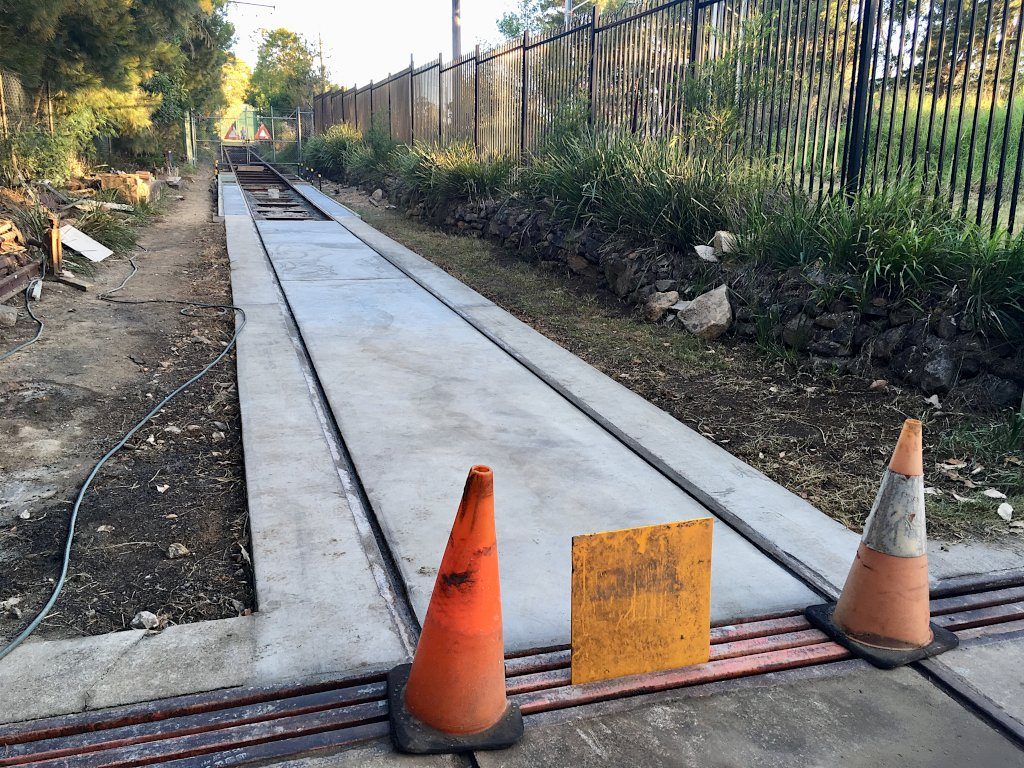
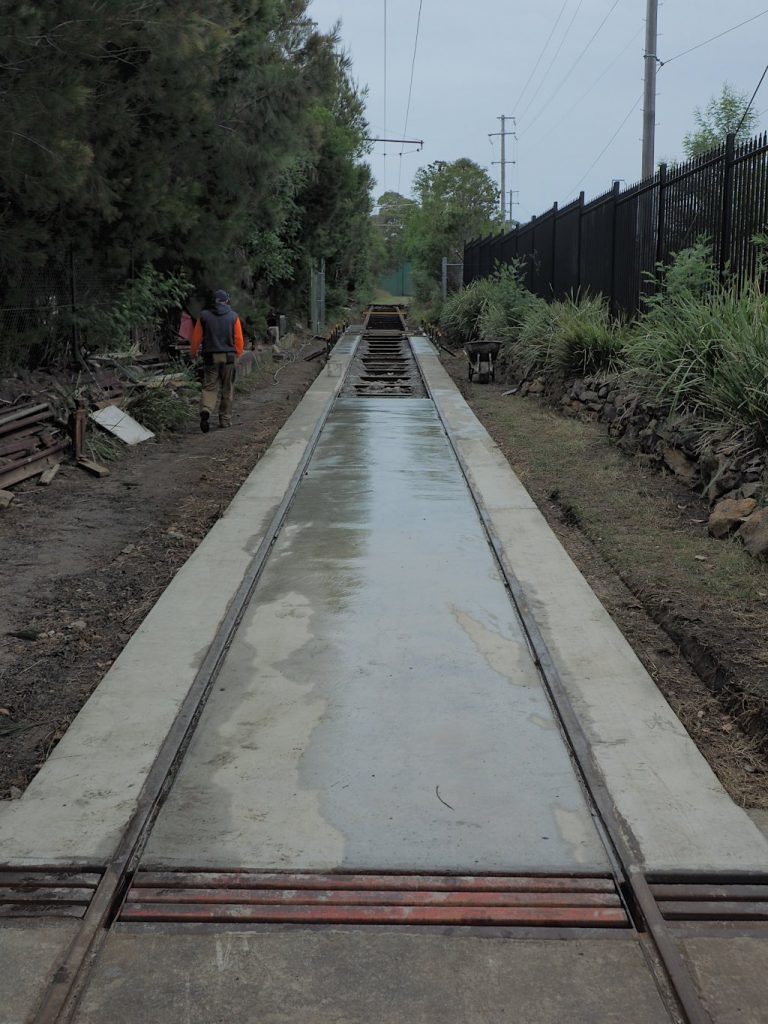
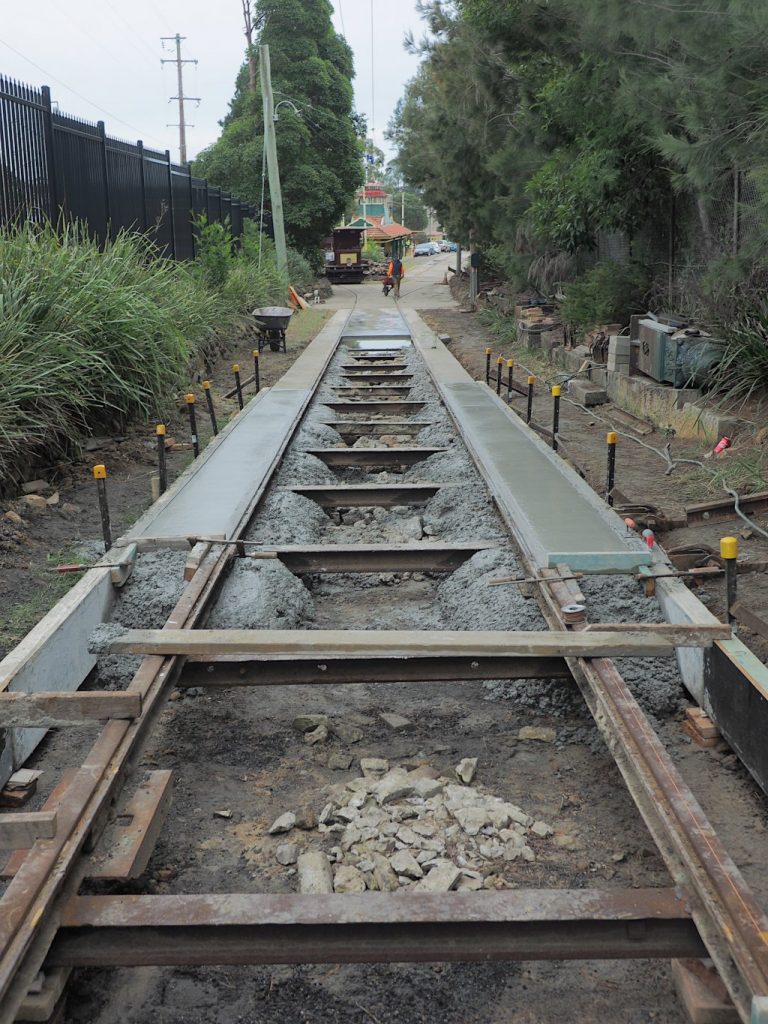
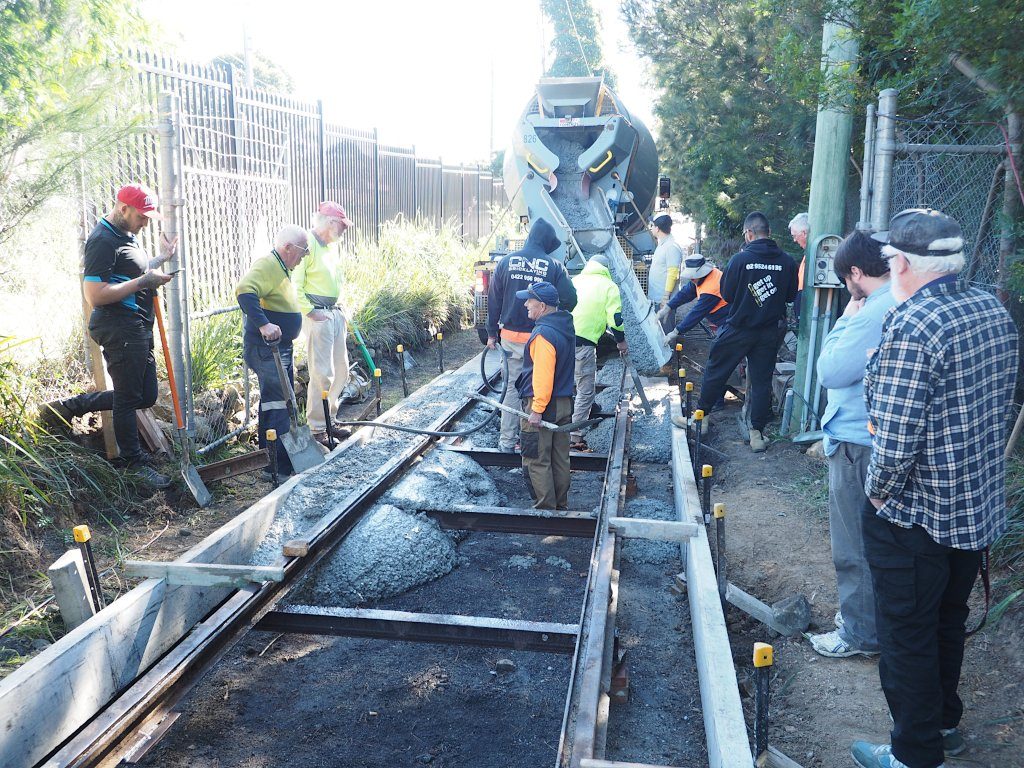
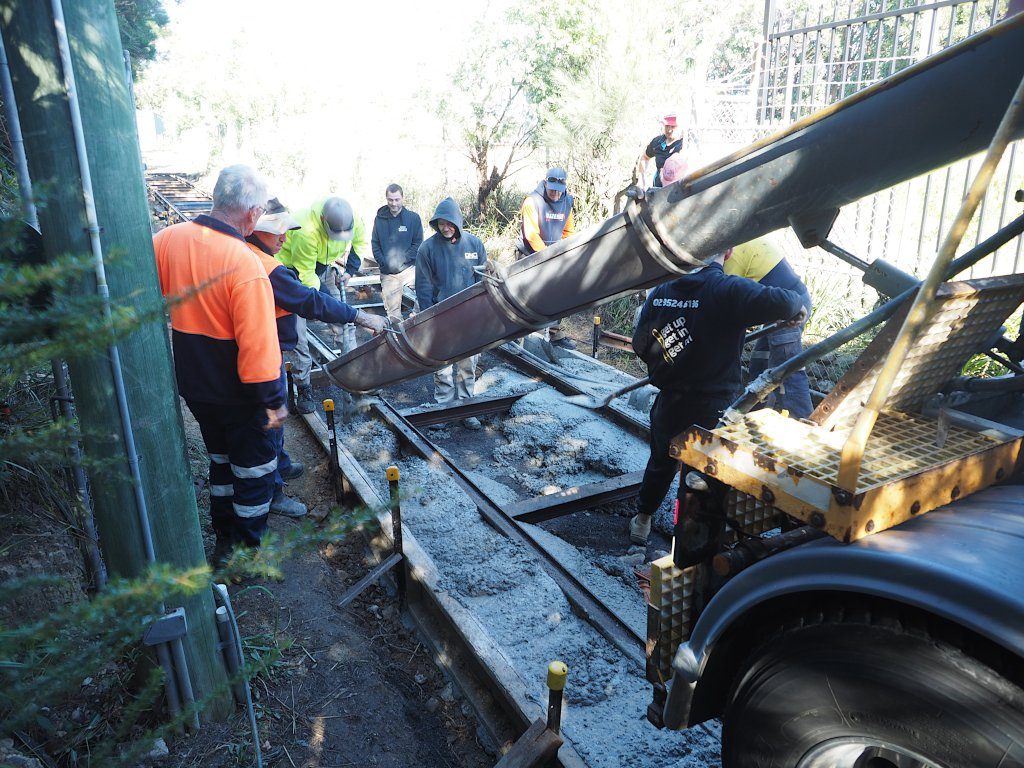
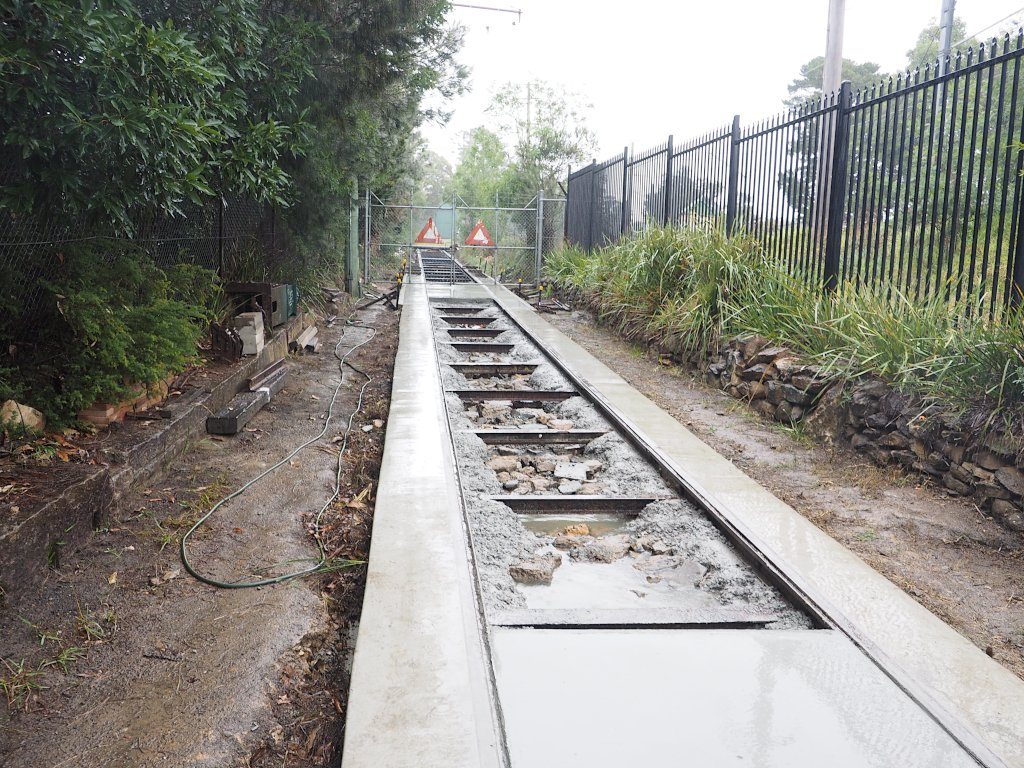
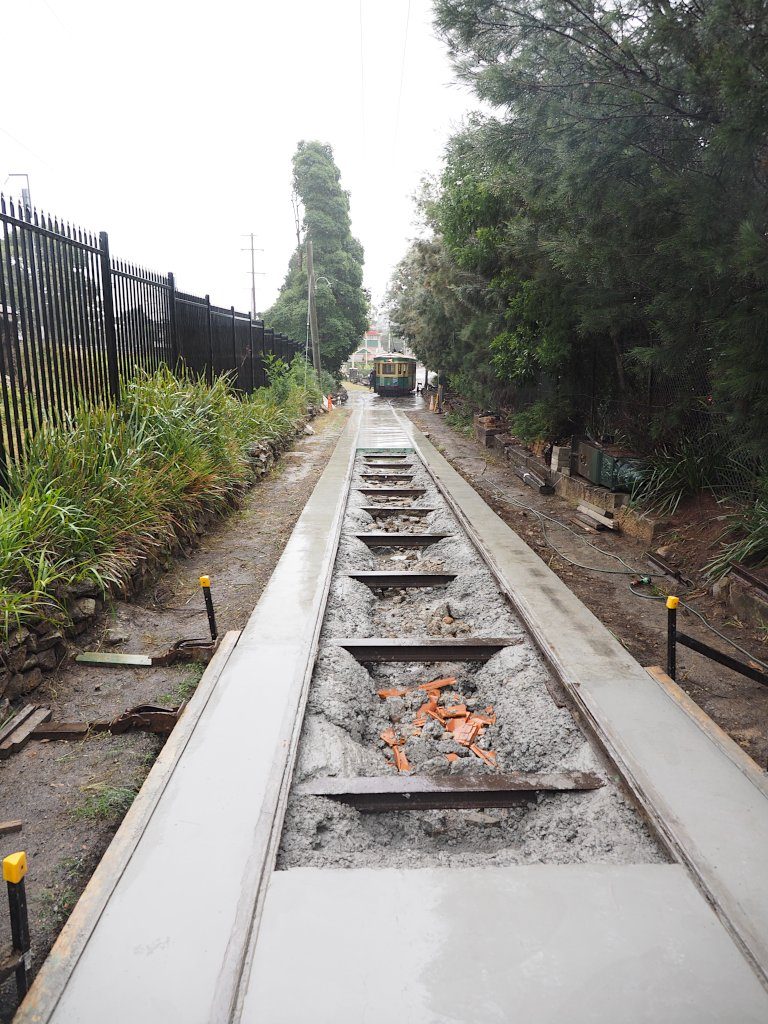
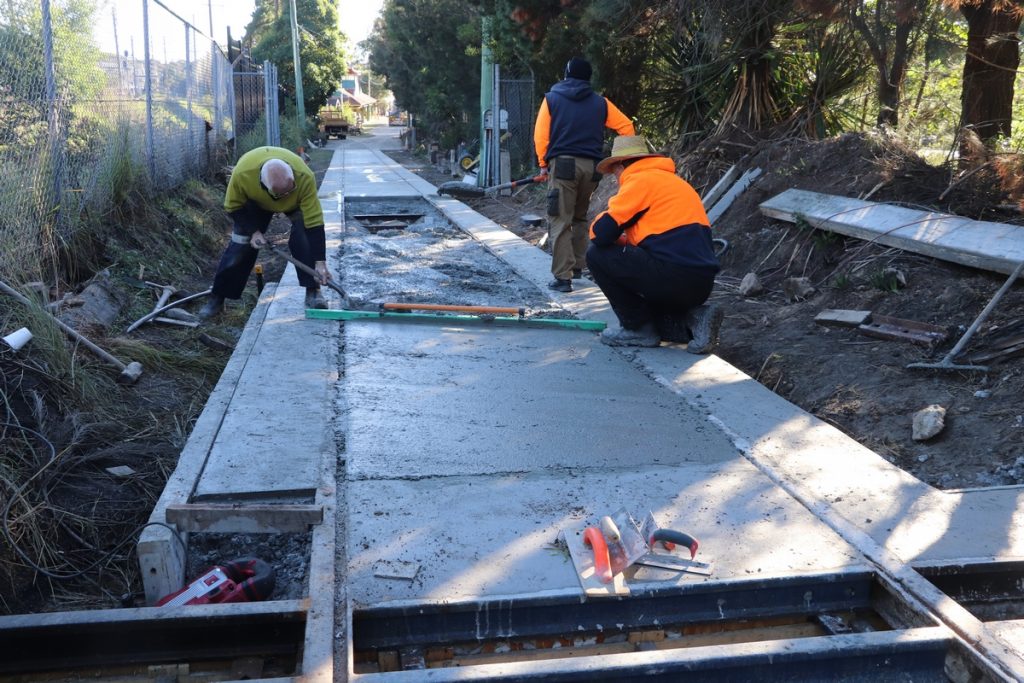
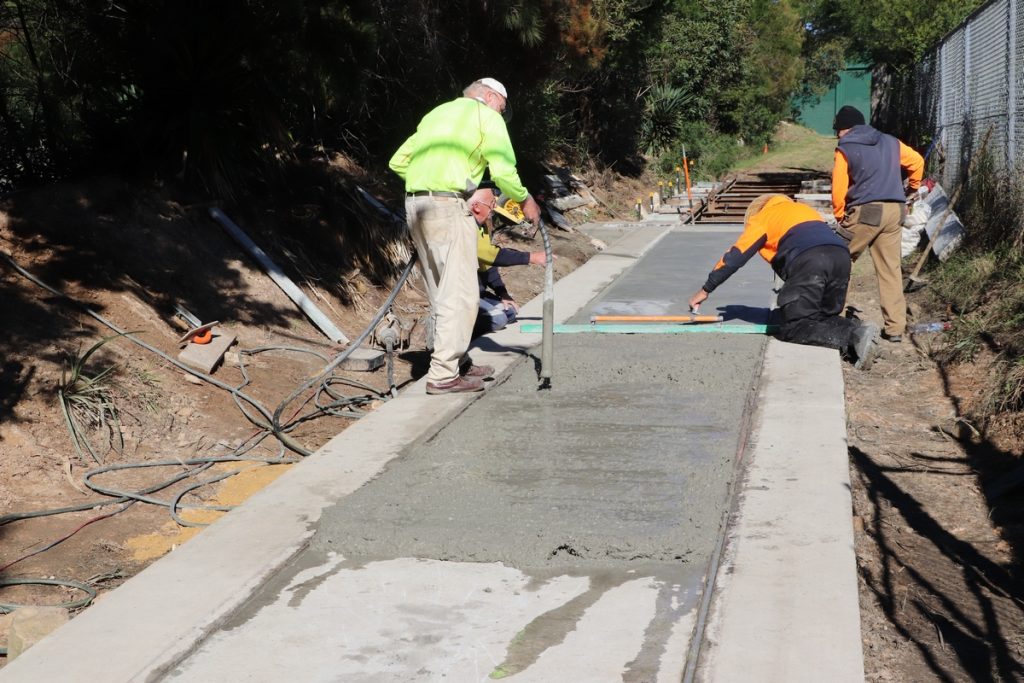
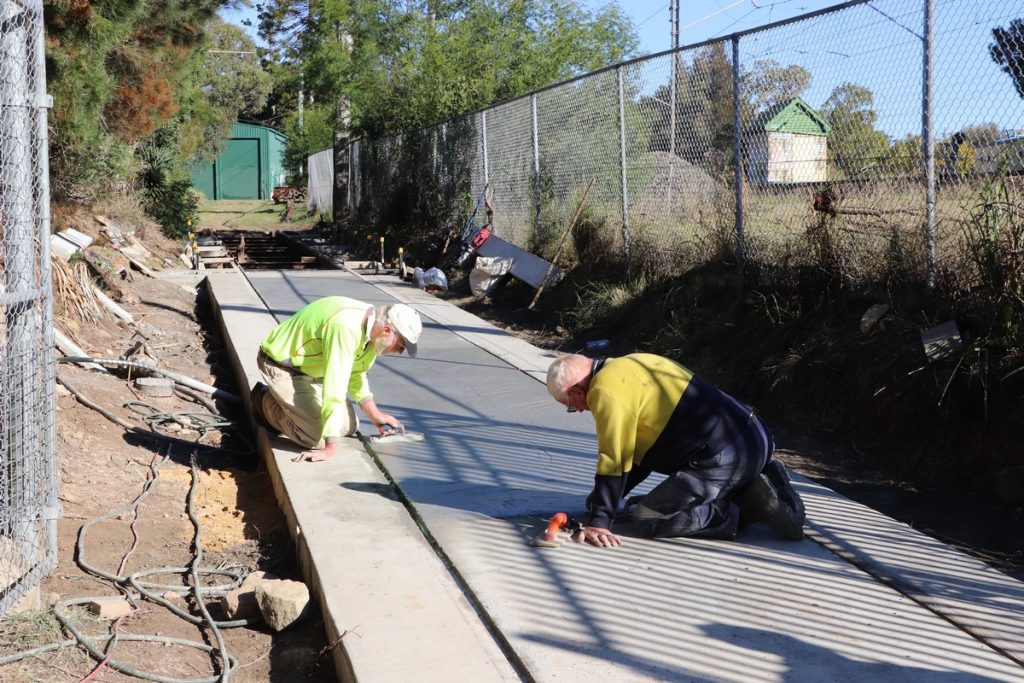
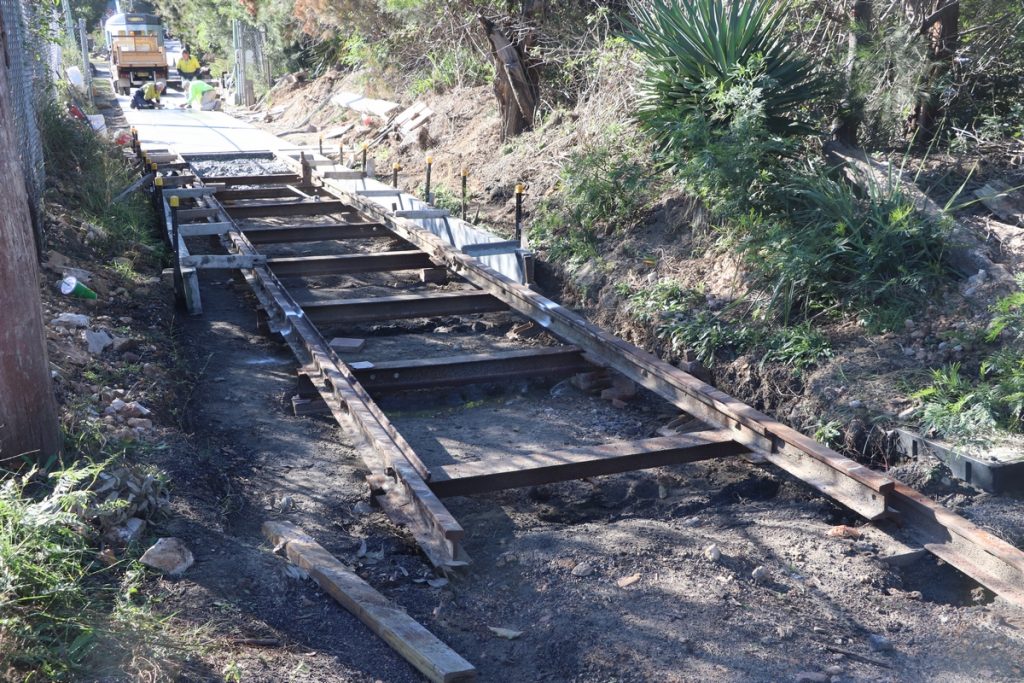
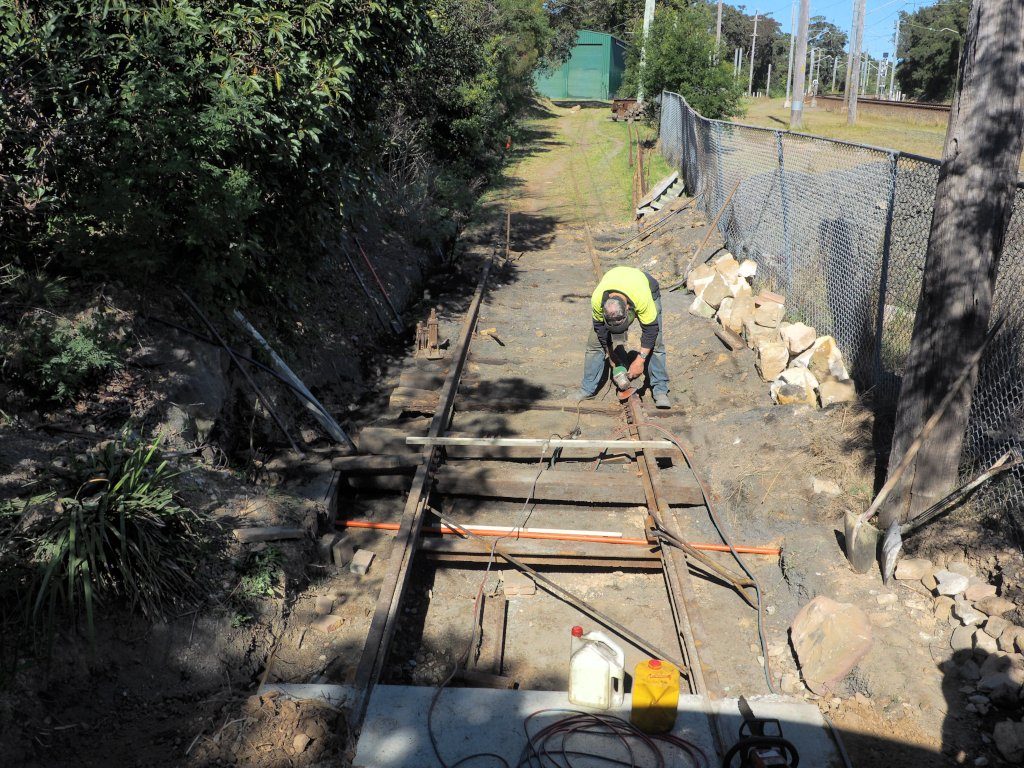
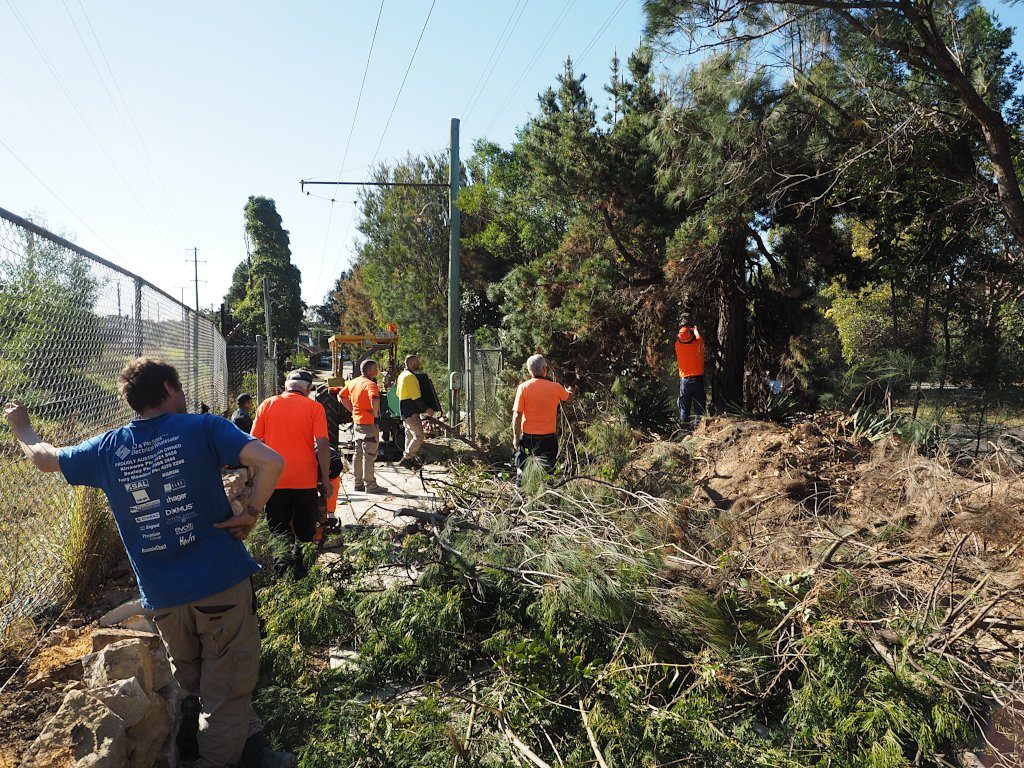
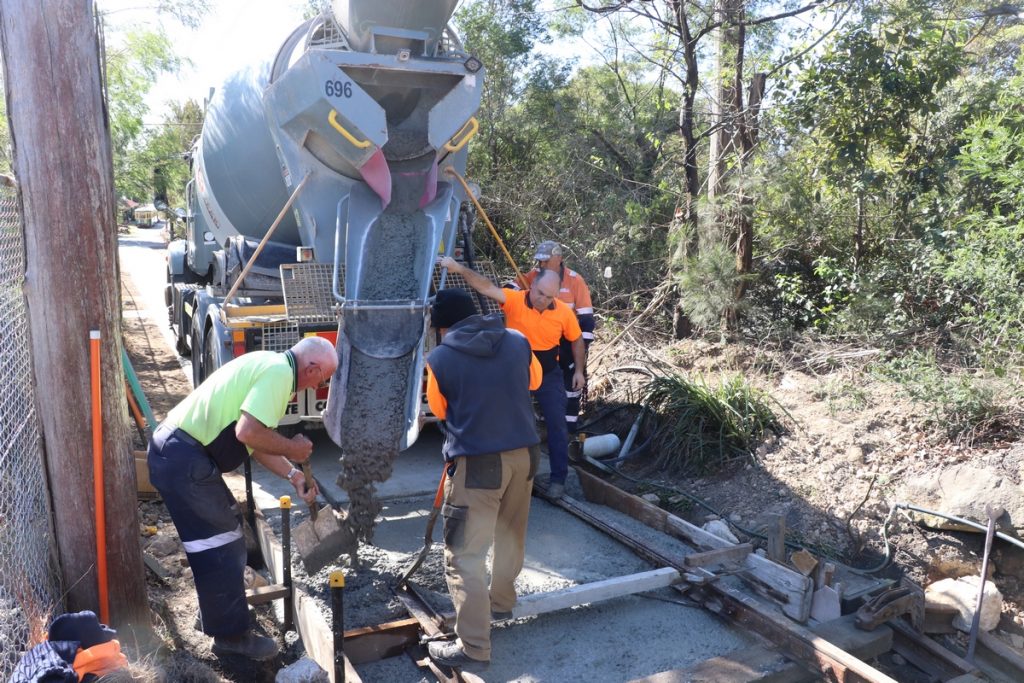
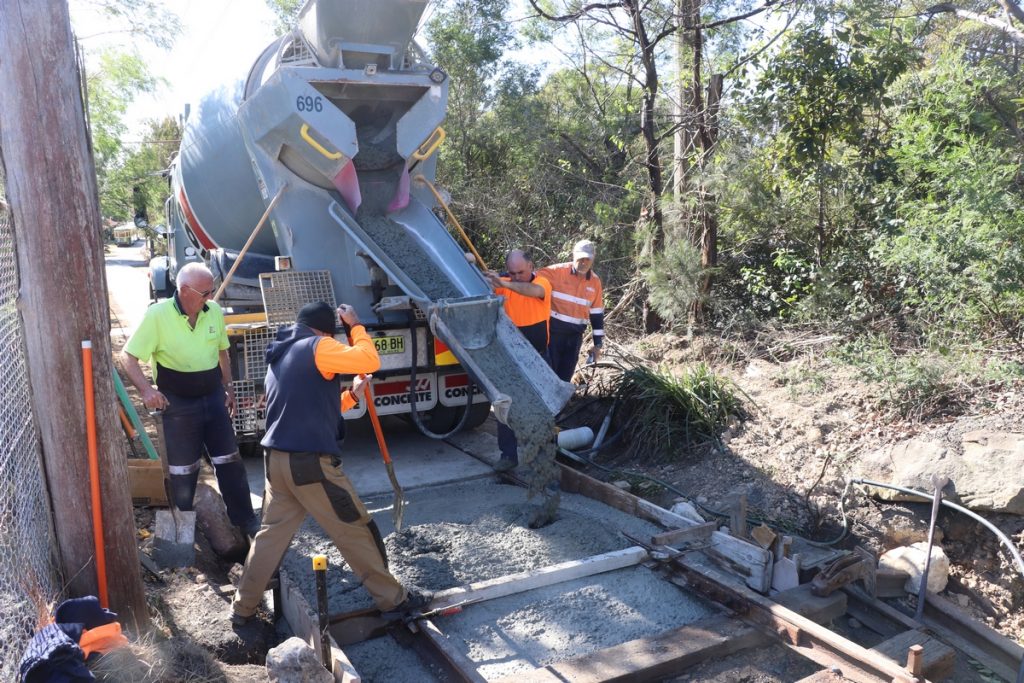
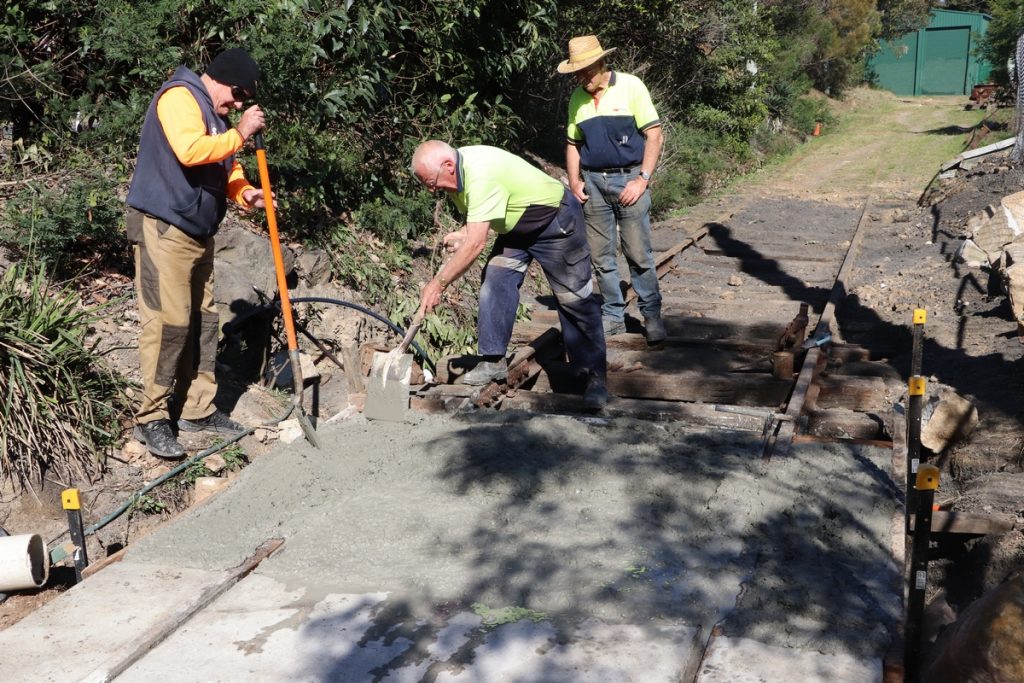
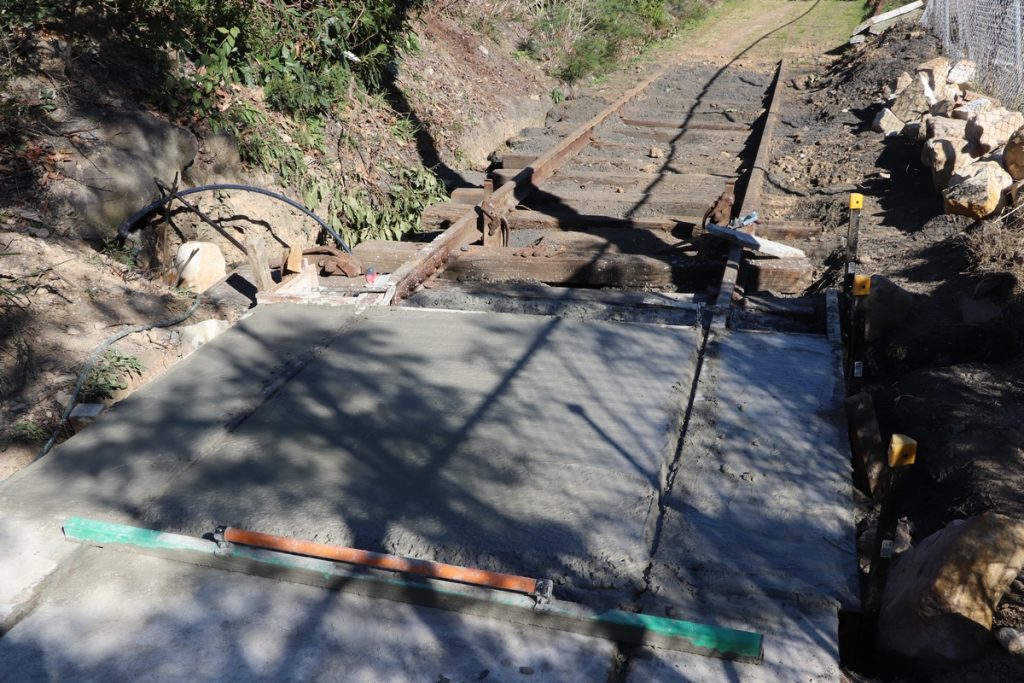
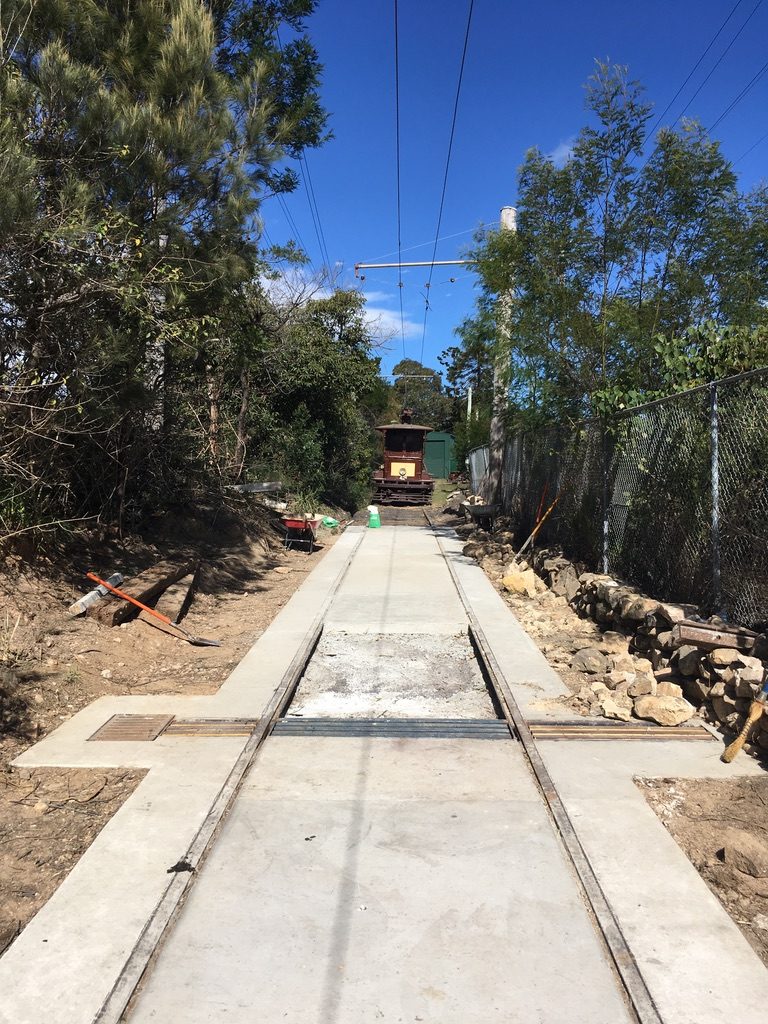
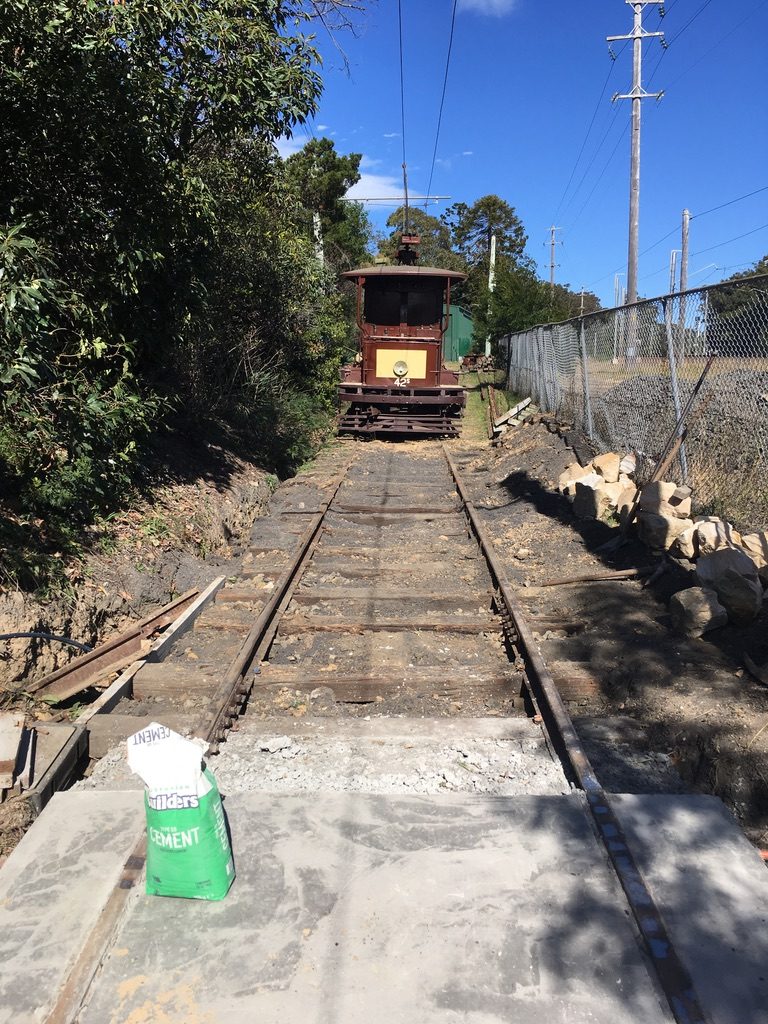
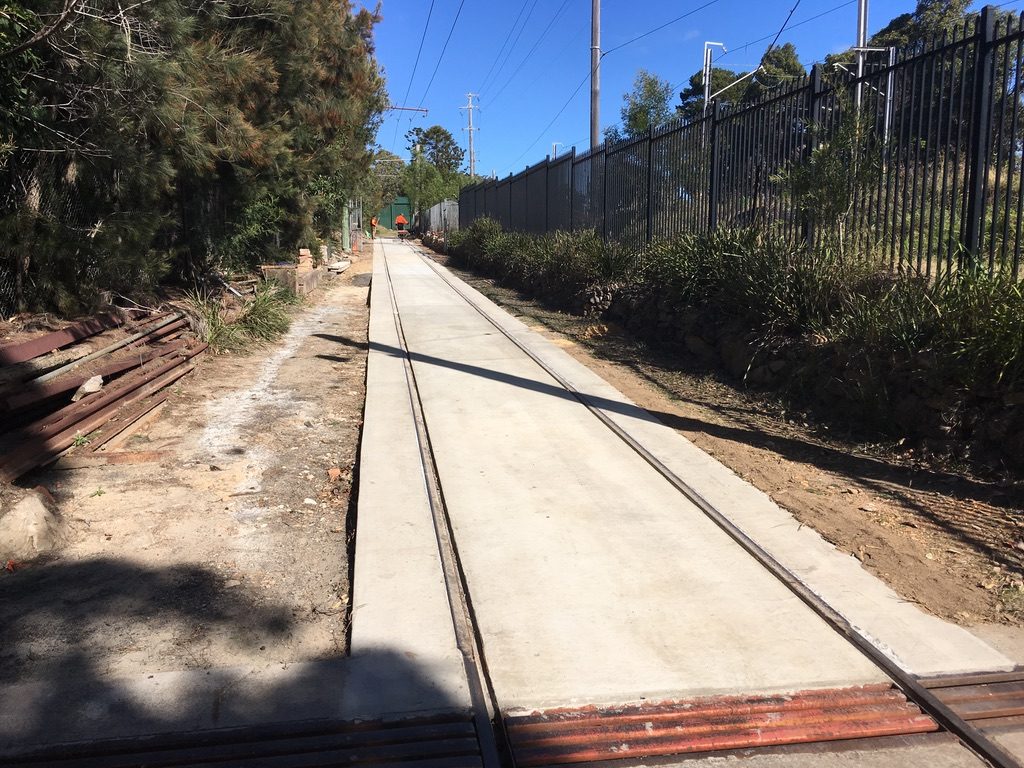
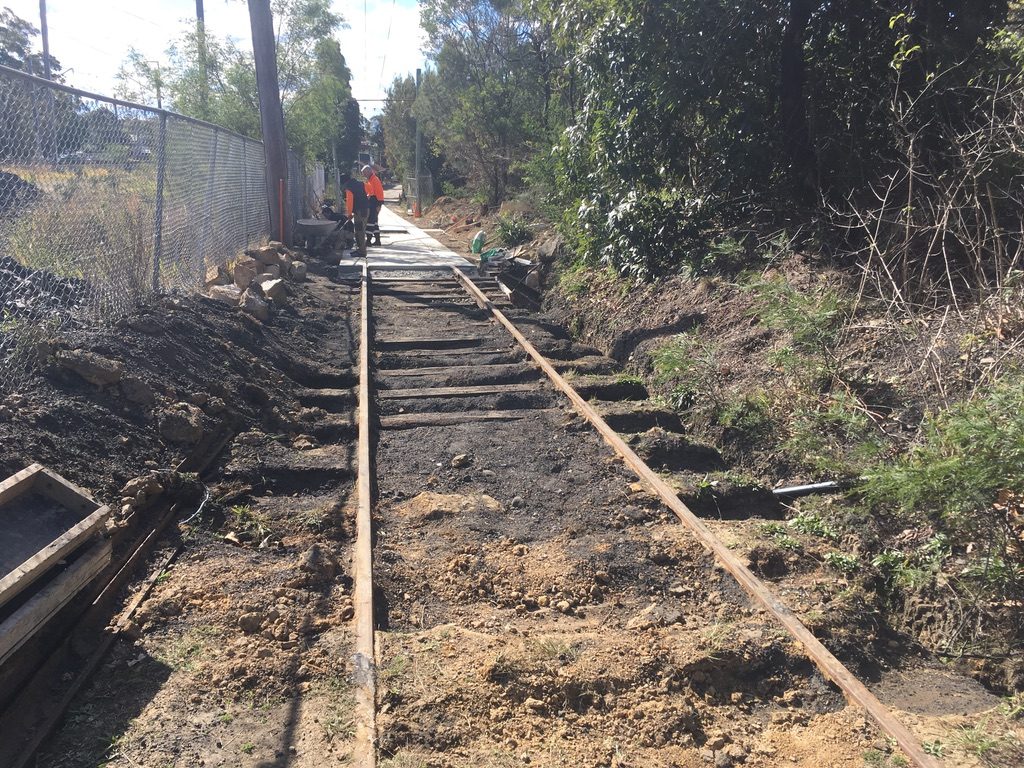



Great photos. When is rail considered worn out and what faults appear? What do you do with it? It’s interesting that rail last used in Feb 1961, is the “new” rail.
When is rail ‘worn out’ is a ‘how long is a piece of string’ question. For grooved rail this is often considered to be when the head has worn down to the point the trams run on their flanges in the groove, but you also consider the pattern of wear on the ‘gauge face’ and how thick the head is, etc, etc. Rail considered too worn for the ‘mainline’ may still be good for a depot siding.
When rail is deemed unusable to run on at Loftus it gets recycled into being sleepers and track drain components.
In the next stage of the South Hill rebuild they will start using old worn out rail as ‘sleepers’ to hold the track in gauge for concreting.
Some of the rails we have recovered over the years have been unusable because it was found the web had corroded too far and was no longer strong enough to connect the head to the foot anymore, despite the head looking to be in good condition.So there is no simple answer to ‘when is rail worn out’.
The Kensington rails we are using for this project were relatively new when the system closed in 1961, so have little wear. Some of the other rails dug up in the eastern suburbs were too worn to reuse.
Great job but weather must be frustrating. Where does the track crew go next after this (other than a well deserved holiday!)? Following Michael’s question, I have heard of rail becoming brittle, how does that happen? Really enjoy this website.
There is always track works that need doing somewhere along the line – sleeper replacement, tree clearing (the things keep growing back!), etc, etc. There is more than enough ongoing maintenance work for the small trackwork gang.
Rail that continually flexes can become fatigued and ‘age harden’ depending on the alloy. Although the main reason I’ve heard for brittle rail is simply low temperatures.
I was a student at UNSW back in the late 1950s and can remember the track replacement work on Anzac Pde. The old track was in very poor condition and was I understand replaced as an expedient. When completed the surface was of tar and not mass concrete as previous track replacement was done.
By then all services were by R and R1 trams and interestingly as they were taken out of service many of those remaining were ex Rozelle cars.
Thank you for the updates. We can’t wait to use the line again. We have been visiting 3-4 times a year, combining the rides with a trip down to Audley. Perfect day out.
Congratulations to the track team for all your hard work and perseverance.
Awesome progress report, I wish more projects are updated like this!